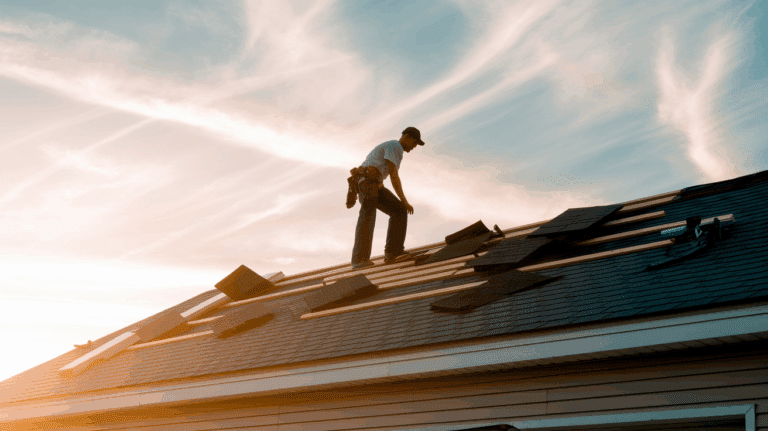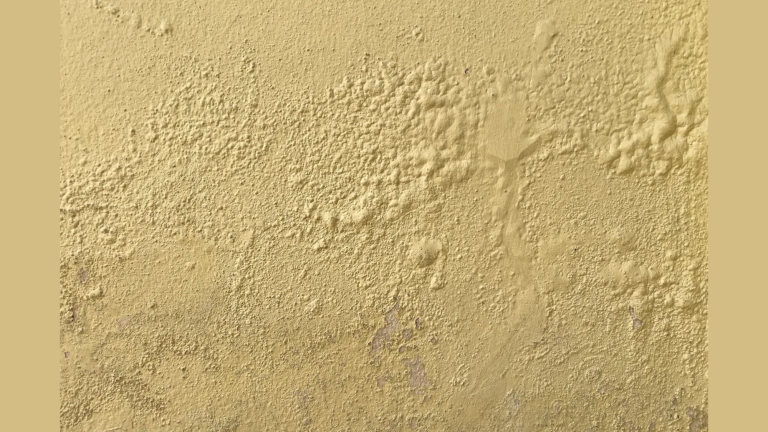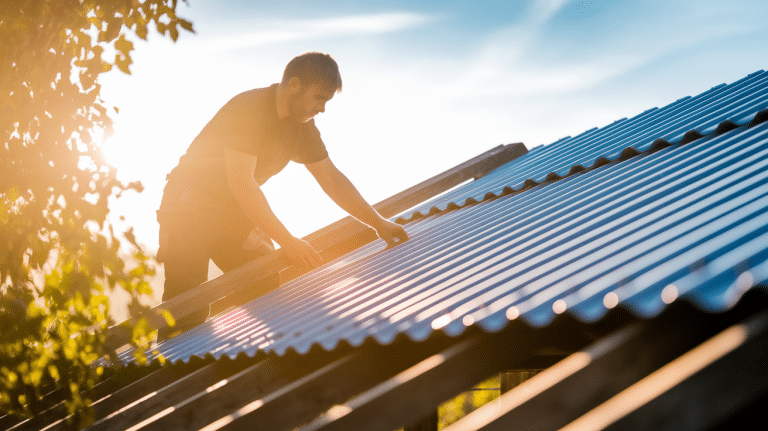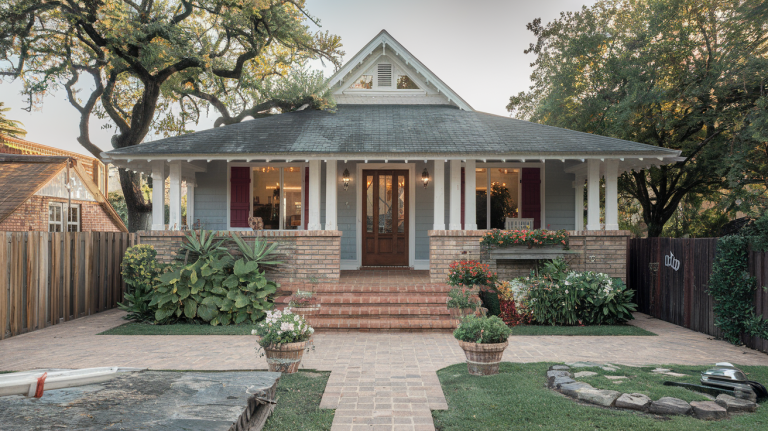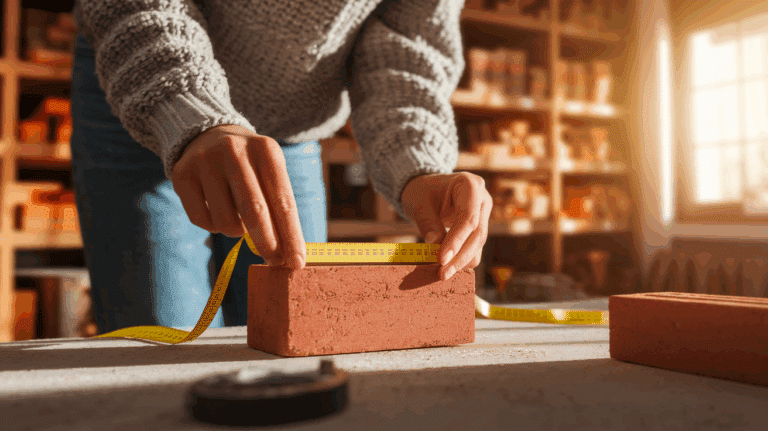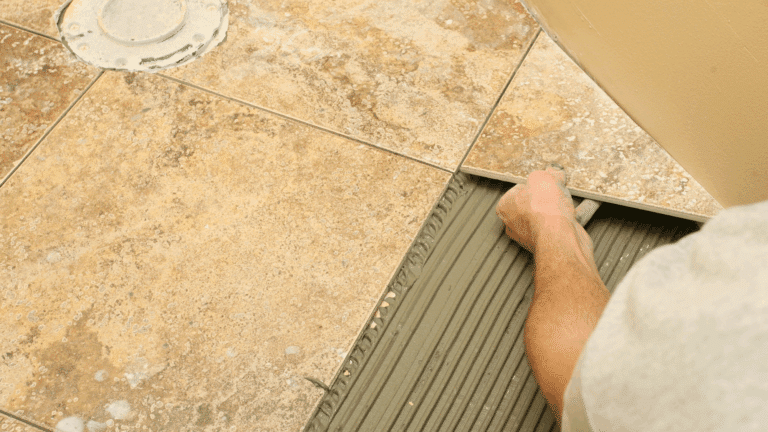31 Best Privacy Fence Types for Your Home
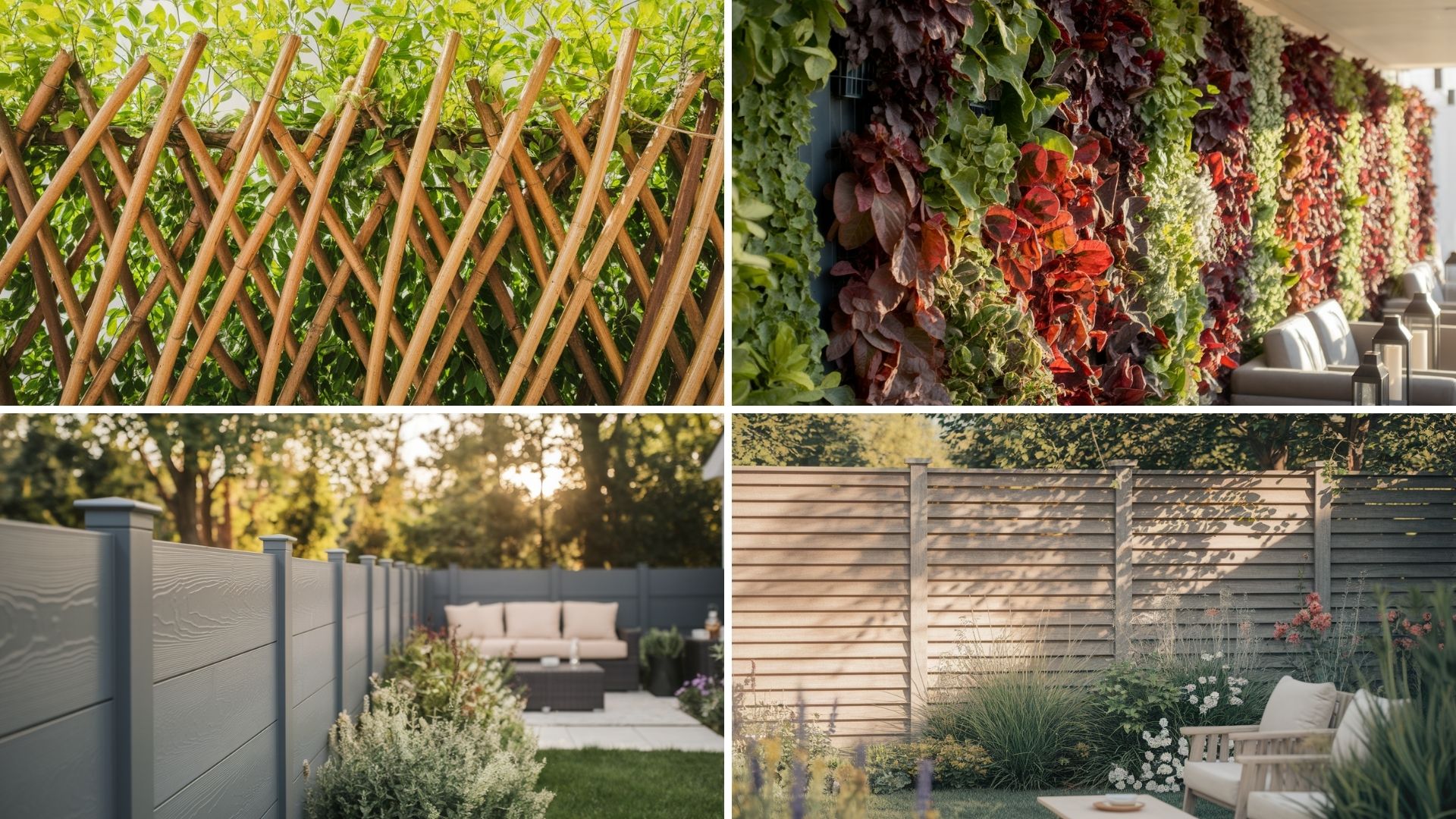
Are your neighbors always peeking into your yard? A good privacy fence can solve this problem.
Privacy fences do more than block views; they add security, reduce noise, and make your outdoor space feel more like home.
But with so many options, picking the right one can be tough.
We will cover various privacy fence types that work for different homes, budgets, and styles. You’ll learn about wooden options, metal choices, and modern items that fit any yard.
Some are quick to set up; others last for years without much care. By the end of this blog, you’ll know exactly which privacy fence fits your needs.
Best Privacy Fence Types for Your Home
Looking for the perfect privacy fence? Here are some top options that combine good looks with practical benefits.
Each type has its own special features, costs, and care needs.
1. Classic Vertical Board Fence
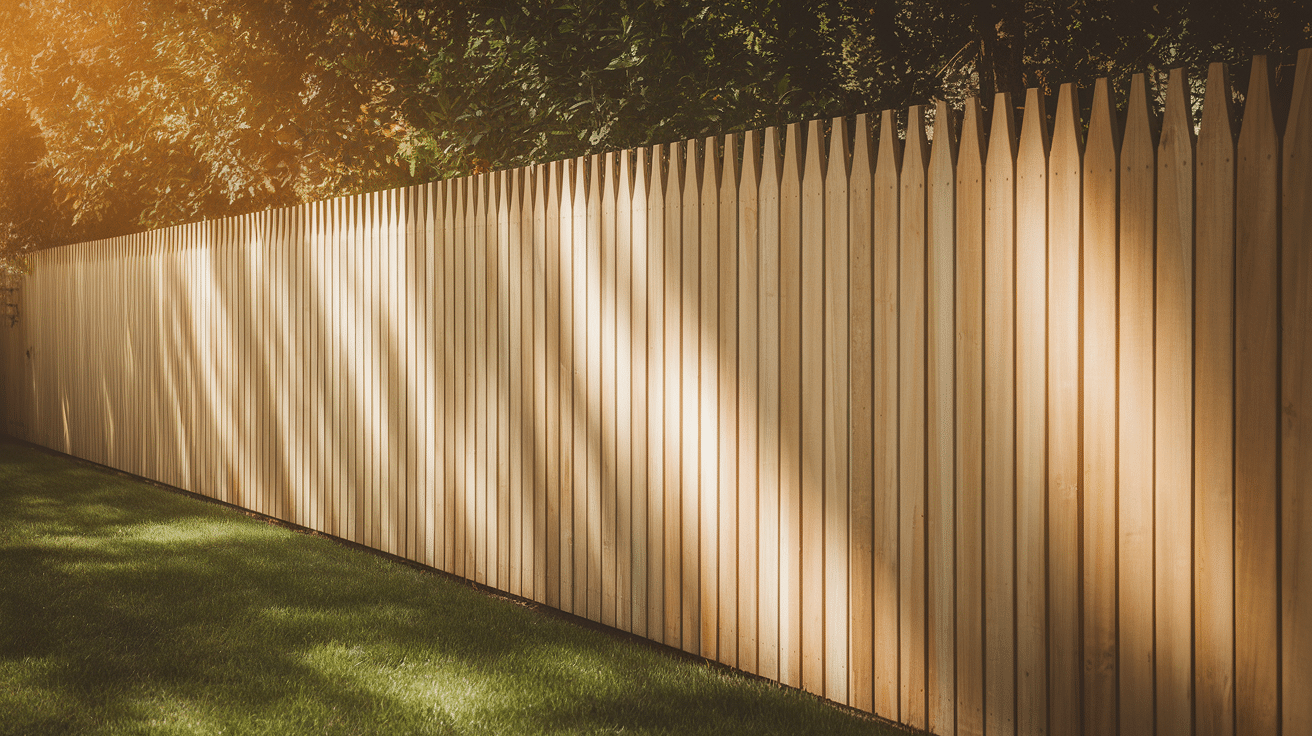
The classic vertical board fence has endured for a good reason. This simple design uses boards placed side by side to create a solid barrier.
- Privacy level: Excellent, creates a complete visual barrier
- Cost: $15-$60 per linear foot
- Lifespan: 15-20 years with proper care
- Best for: Homeowners wanting traditional looks with maximum privacy
Maintaining these fences means checking for loose boards yearly and resealing or staining every 2-3 years.
Pressure-treated pine offers good value, but cedar and redwood last longer with less upkeep.
2. Shadowbox Fence (Alternating Boards)
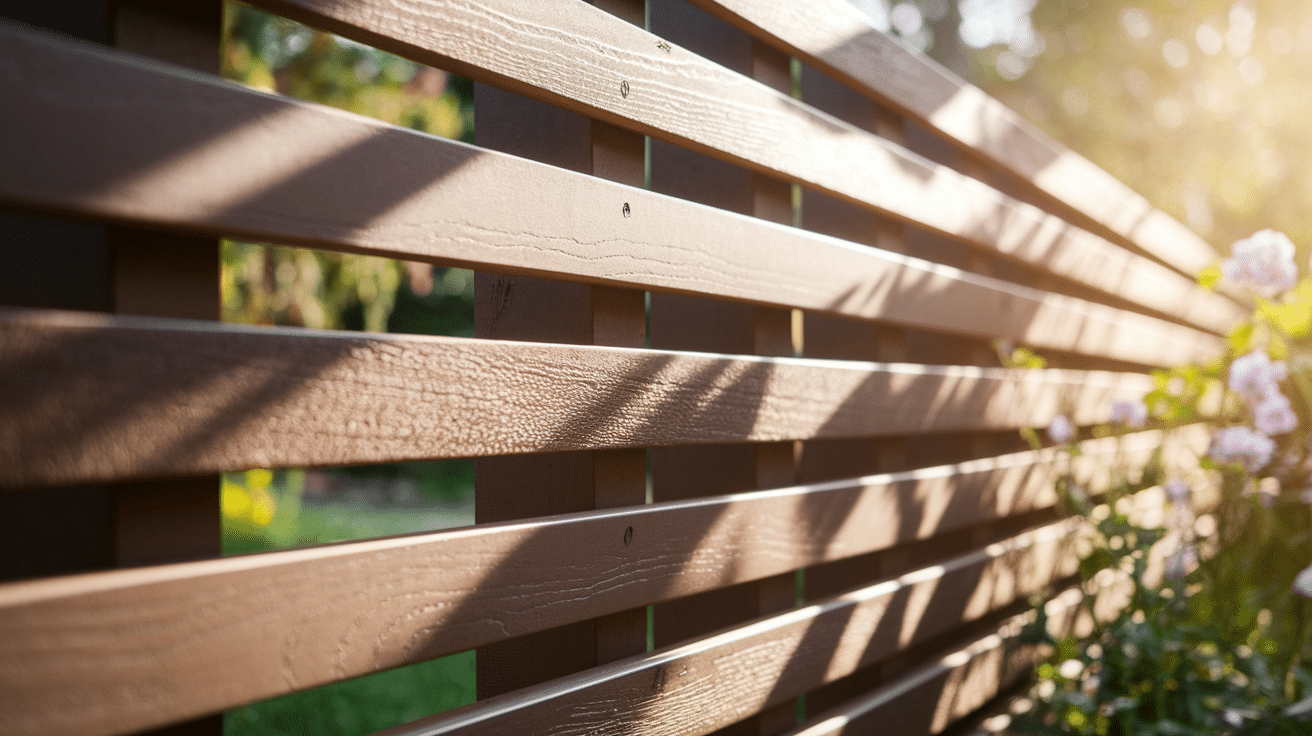
The shadowbox fence places boards on opposite sides of the rail, creating a pattern that looks the same from both sides. Your neighbors will appreciate this thoughtful touch!
- Privacy level: Good, small gaps between boards
- Cost: $18-$35 per linear foot
- Lifespan: 15+ years
- Best for: Yards where appearance from both sides matters
This style requires the same care as classic board fences, but it handles wind better due to the gaps.
The alternating pattern creates interesting shadow effects as the sun moves.
3. Board-on-Board Fence
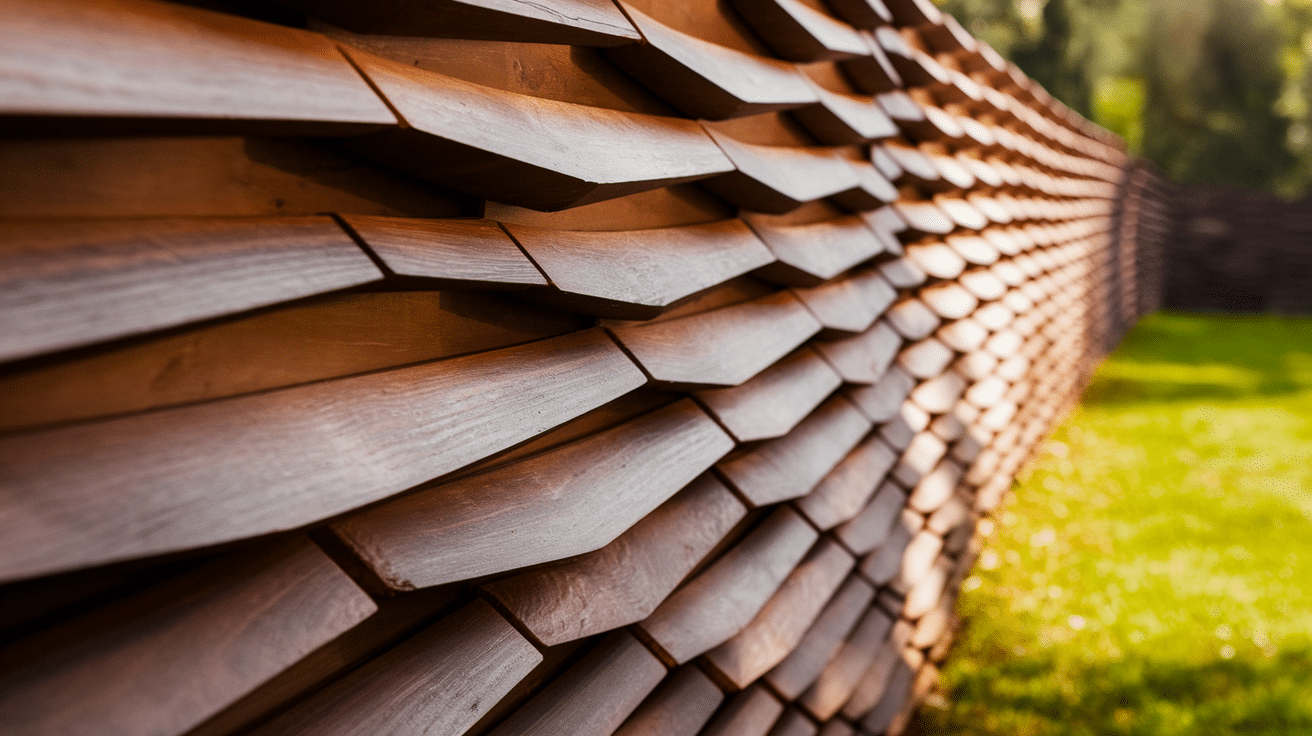
Board-on-board fences overlap slightly, ensuring no gaps even as wood shrinks over time. This design creates a very strong, long-lasting privacy solution.
- Privacy level: Superior, no gaps, even as wood ages
- Cost: $15-$75 per linear foot
- Lifespan: 20+ years
- Best for: Areas with changing weather that causes wood to expand/contract
This fence style costs a bit more since it uses extra wood for the overlaps. The payoff comes in longer-lasting privacy and a distinctive layered look.
4. Lattice-Top Wood Fence
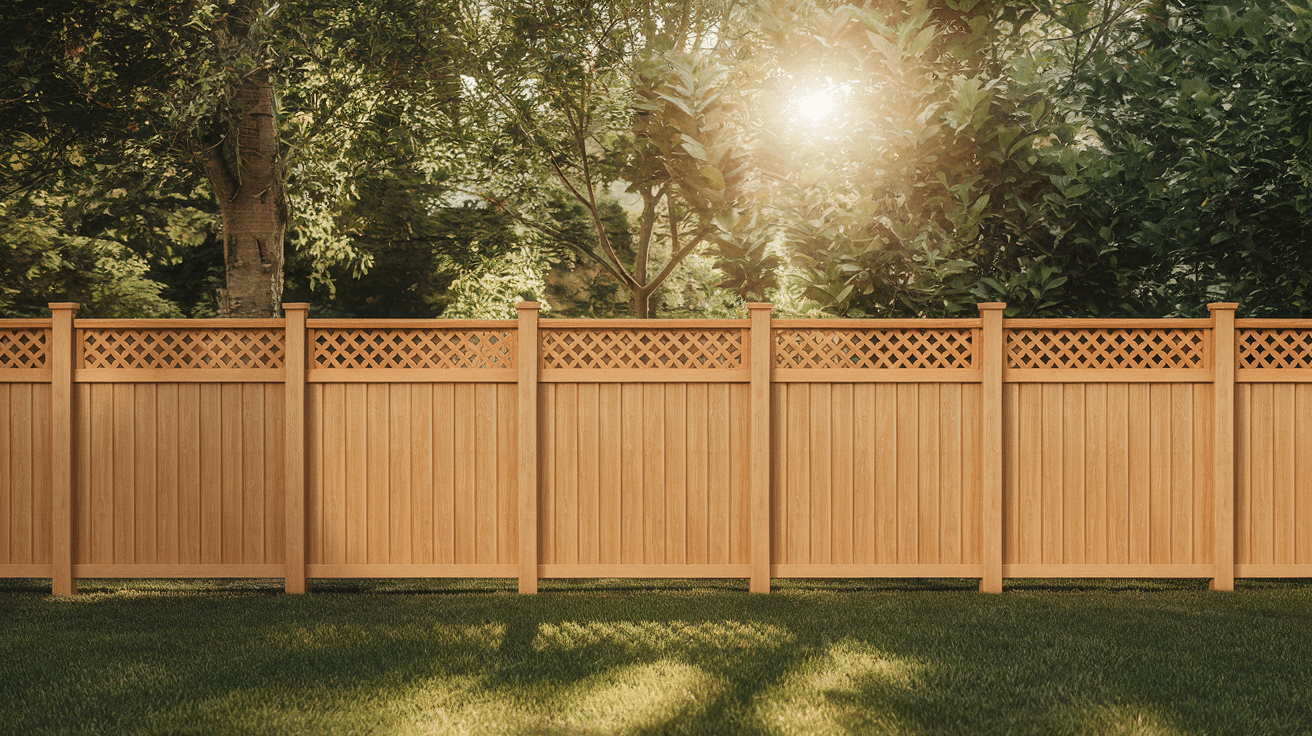
A lattice-top wood fence combines solid lower panels with decorative lattice at the top. This mix creates privacy where needed while letting light and air pass through above.
- Privacy level: Mixed, solid below, filtered above
- Cost: $25-$45 per linear foot
- Lifespan: 12-15 years (lattice may need earlier replacement)
- Best for: Gardens where plants need airflow or yards needing a less boxy look
The lattice sections need extra attention during cleaning and painting. The open pattern catches more dirt but adds visual interest and feels less confining.
5. Horizontal Slat Wood Fence
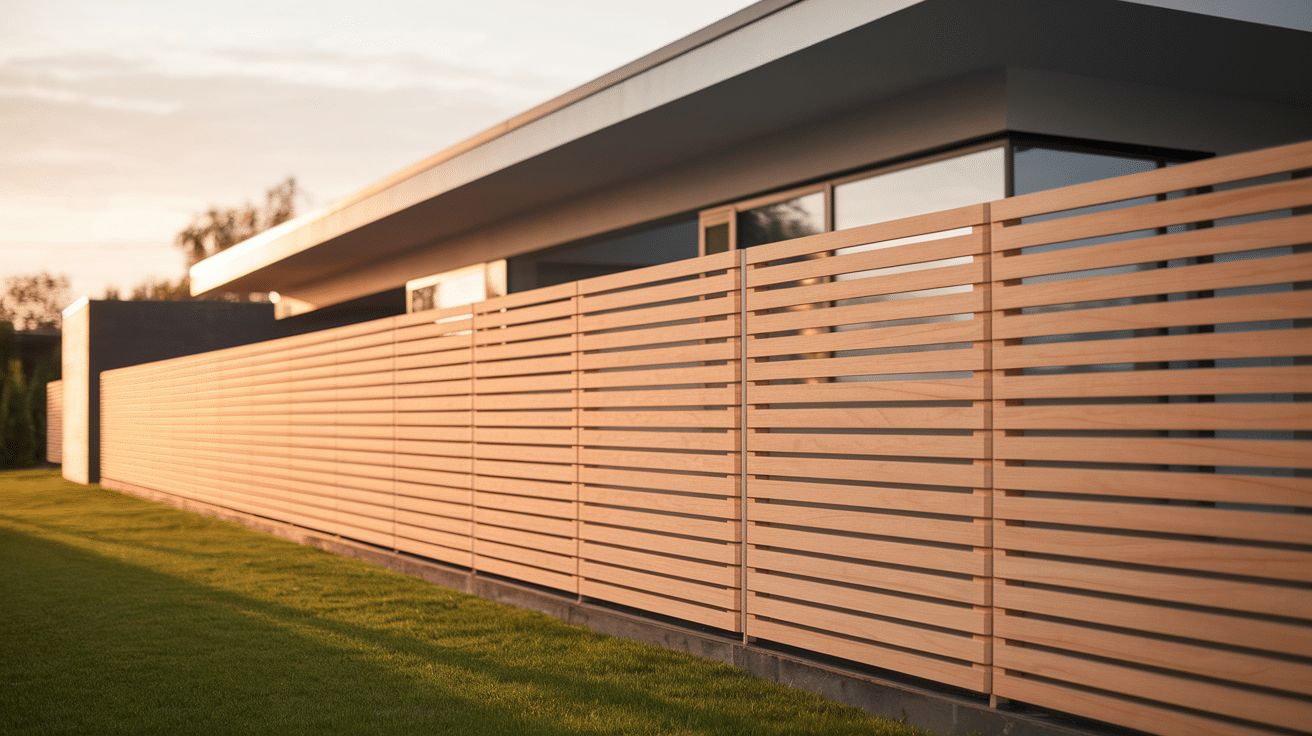
Horizontal slat fences use boards running side to side instead of up and down. This modern style catches the eye and makes spaces seem wider.
- Privacy level: Variable (depends on gap size between slats)
- Cost: $15-$55 per linear foot
- Lifespan: 10-15 years
- Best for: Modern homes seeking a current, fashionable look
These fences need strong posts since the horizontal boards don’t add structural strength. They work great on flat land but can look off-kilter on slopes.
6. Rustic Split Rail with Wire Mesh
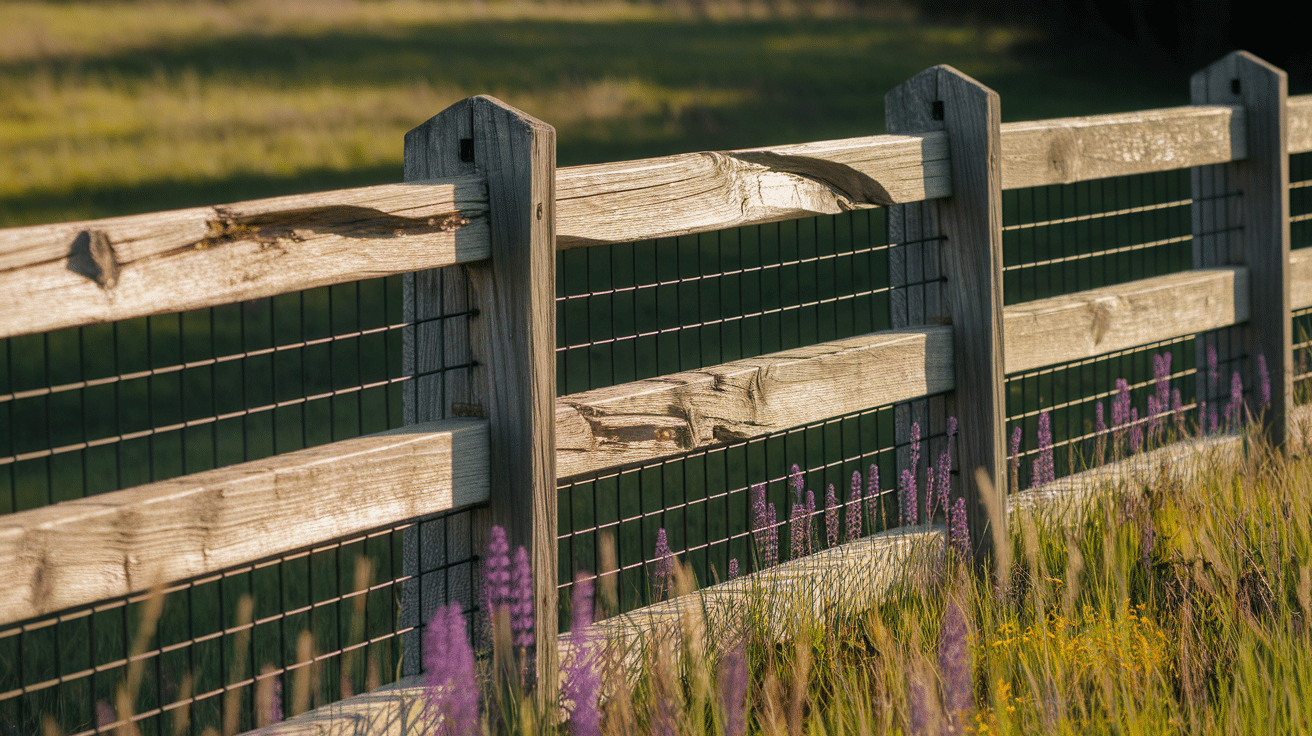
Split rail fences with added wire mesh offer a country feel while keeping pets and kids safe. The mesh hides behind the rails but does the real work.
- Privacy level: Low (mainly for boundary marking and containment)
- Cost: $12-$40 per linear foot
- Lifespan: 20+ years
- Best for: Large rural or semi-rural properties needing pet containment with rustic charm
This low-maintenance option requires minimal care, with only occasional wire checks needed.
Adding fast-growing vines to the mesh can increase privacy over time.
7. Picket Fence with Privacy Panels
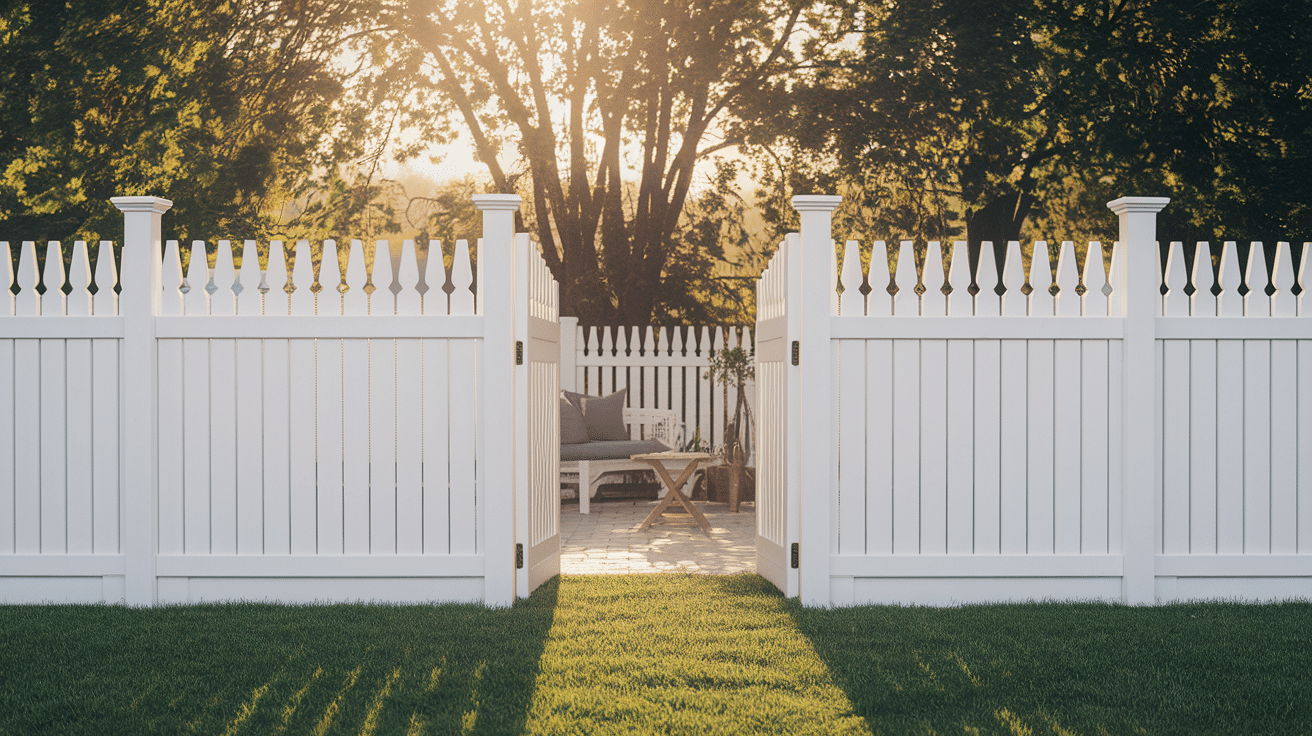
Standard picket fences can gain privacy with solid panel inserts in key areas. This versatile option lets you choose exactly where privacy matters most.
- Privacy level: Partial (targeted privacy in specific areas)
- Cost: $15-$30 per linear foot
- Lifespan: 15+ years
- Best for: Front yards wanting some privacy without losing the friendly picket fence look
The mixed materials mean different maintenance needs.
Panels might need more frequent painting than the pickets themselves. This option works well for hiding specific areas like air conditioning units or trash cans.
8. Solid Vinyl Panel Fence
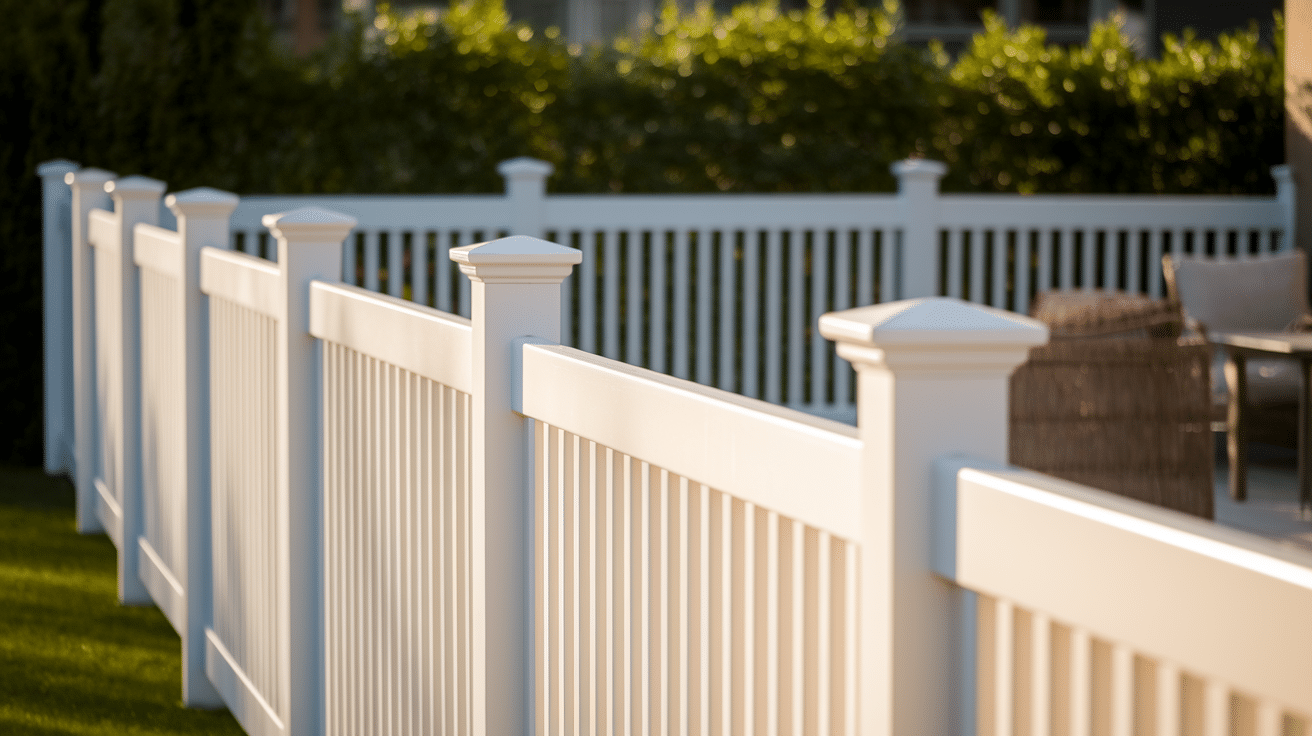
Solid vinyl panel fences offer complete privacy with almost no upkeep. The panels snap together for a clean look without gaps or spaces.
- Privacy level: Complete, totally blocks views
- Cost: $25-$45 per linear foot
- Lifespan: 20-30+ years
- Best for: Homeowners who want long-term privacy with minimal work
These fences never need painting or staining. Just wash them with soap and water once a year to keep them looking fresh.
The color goes all the way through the material, so scratches are barely noticeable.
9. Vinyl Picket Privacy Fence
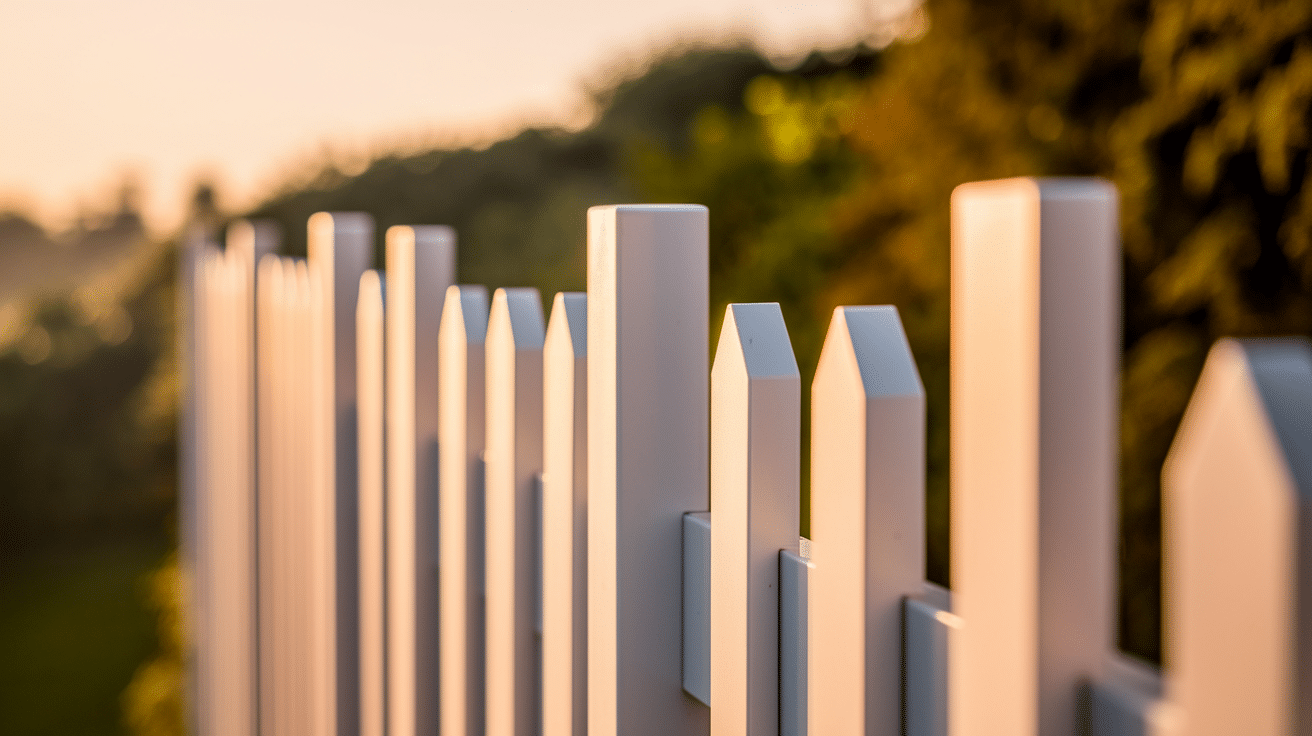
Vinyl picket privacy fences use closely spaced pickets to block views while keeping a more open feel than solid panels. The small gaps between pickets let some air flow through.
- Privacy level: High, small gaps allow minimal visibility
- Cost: $20-$35 per linear foot
- Lifespan: 20-30 years
- Best for: Areas with strong winds or where a slightly less boxed-in look is wanted
The gaps in this style help it stand up to heavy winds better than solid panels.
Like other vinyl fences, they only need occasional cleaning with soap and water to stay looking new.
10. Vinyl Lattice-Top Privacy Fence
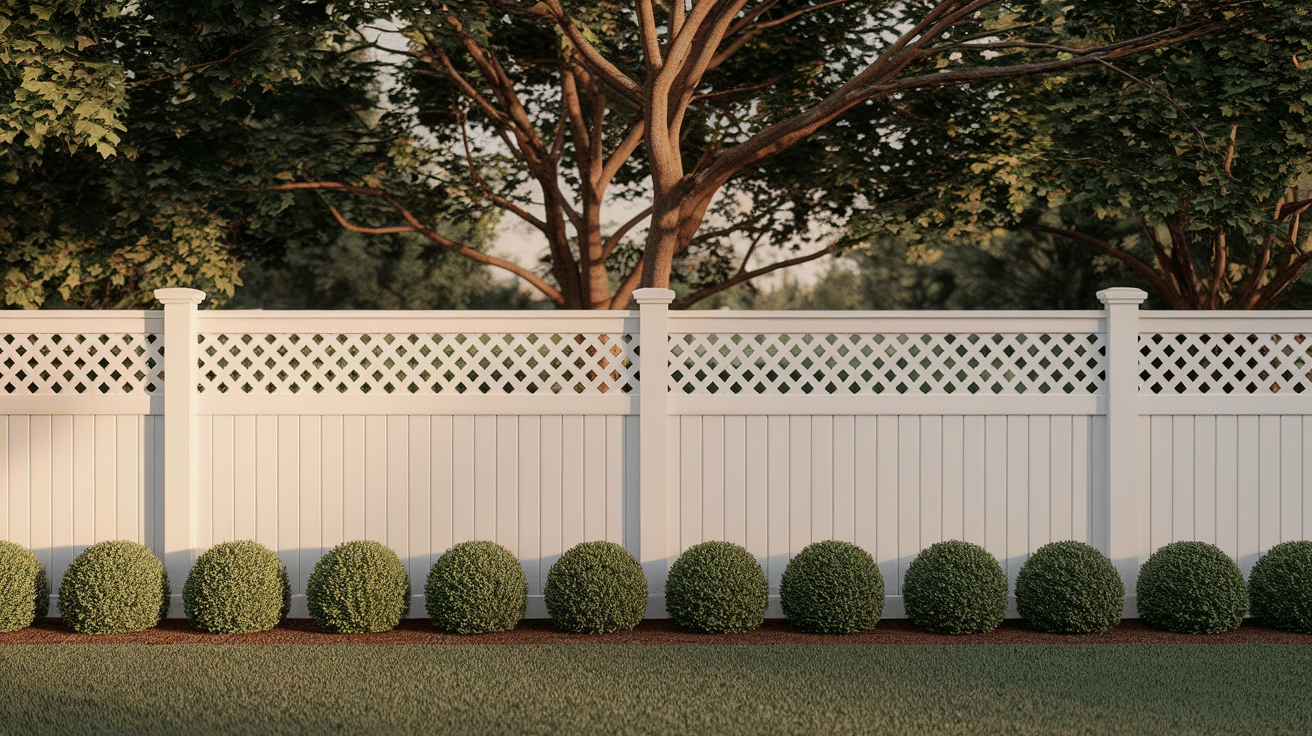
Vinyl lattice-top privacy fences pair solid lower sections with decorative lattice at the top. This mix adds style while keeping the main living area private.
- Privacy level: Mixed, complete below, partial above
- Cost: $30-$50 per linear foot
- Lifespan: 25+ years
- Best for: Homeowners wanting to soften the look of a privacy fence
The lattice section lets light and breeze pass through, while the lower section keeps activities private.
Unlike wood lattice, vinyl versions won’t rot or need painting, but they might collect more dirt in the small spaces.
11. Textured Vinyl (Wood-Look) Fence
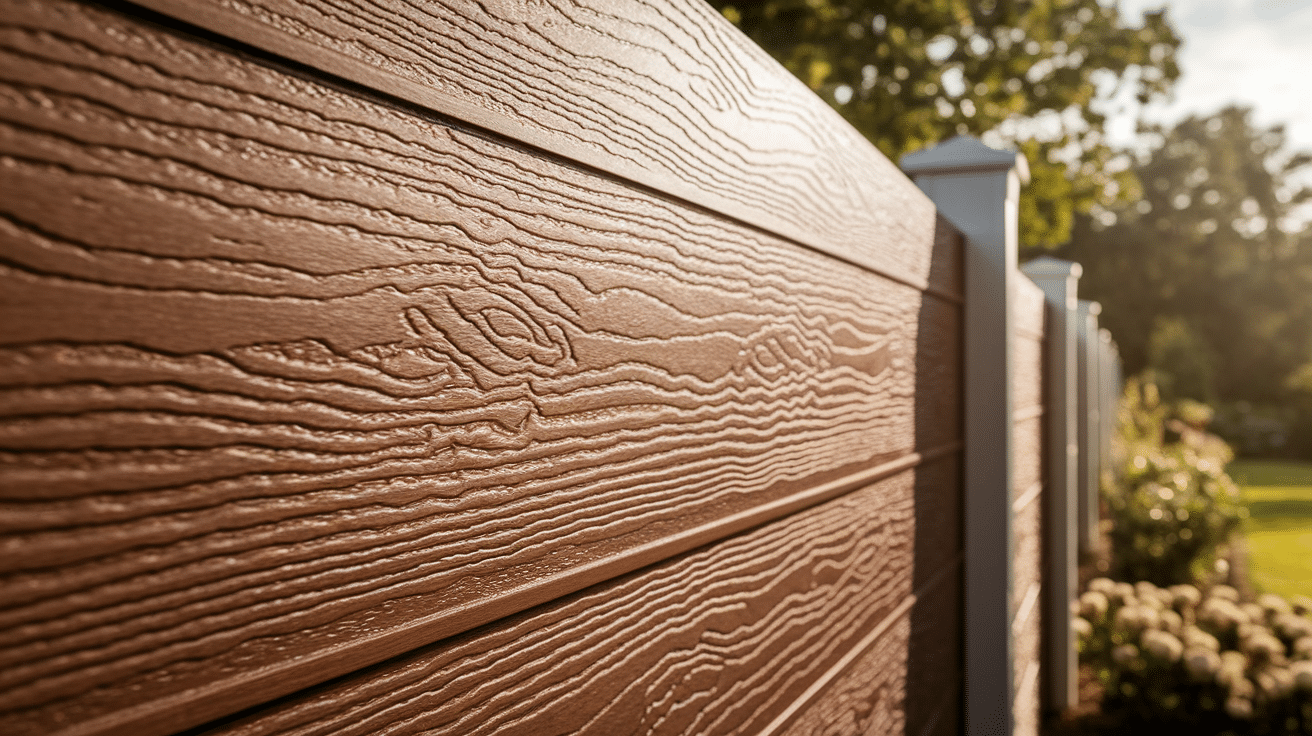
Textured vinyl fences mimic the look of wood grain but offer vinyl’s easy care. Modern versions look surprisingly close to real wood from just a few feet away.
- Privacy level: Complete, solid panels with no gaps
- Cost: $30-$55 per linear foot
- Lifespan: 20-30 years
- Best for: People who like wood’s look but hate wood’s upkeep
These fences come in various wood-like colors, from light oak to rich walnut.
The texture helps hide dirt and fingerprints better than smooth vinyl, making them look cleaner longer between washings.
12. Scalloped Vinyl Privacy Fence
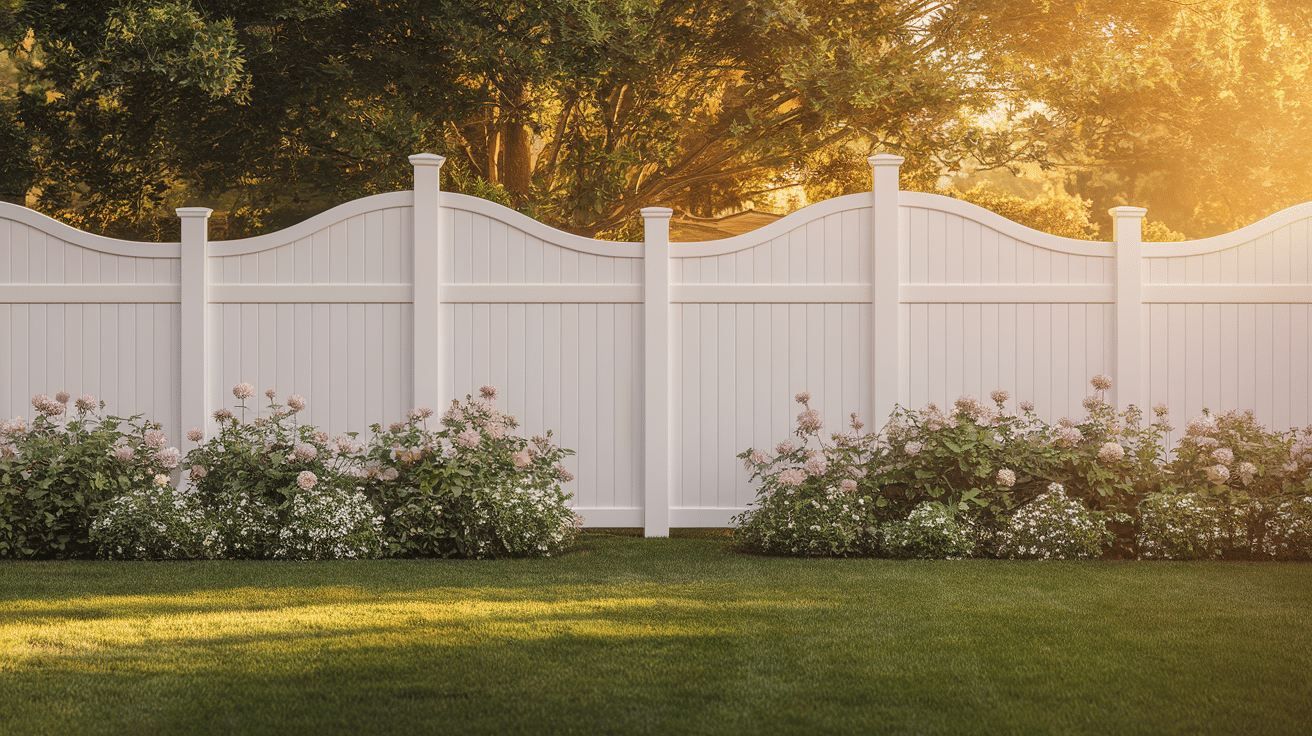
Scalloped vinyl privacy fences have a decorative curved top that softens the look while maintaining full privacy.
The gentle arch adds visual interest to straight fence lines.
- Privacy level: Complete, solid panels with decorative top
- Cost: $35-$60 per linear foot
- Lifespan: 20-30 years
- Best for: Traditional homes or gardens where a softer fence line is wanted
This fence style works well to mark garden rooms or create a more formal look.
The curved top needs no extra care but makes the fence look more custom and thoughtful.
13. Aluminum Privacy Fence with Slats
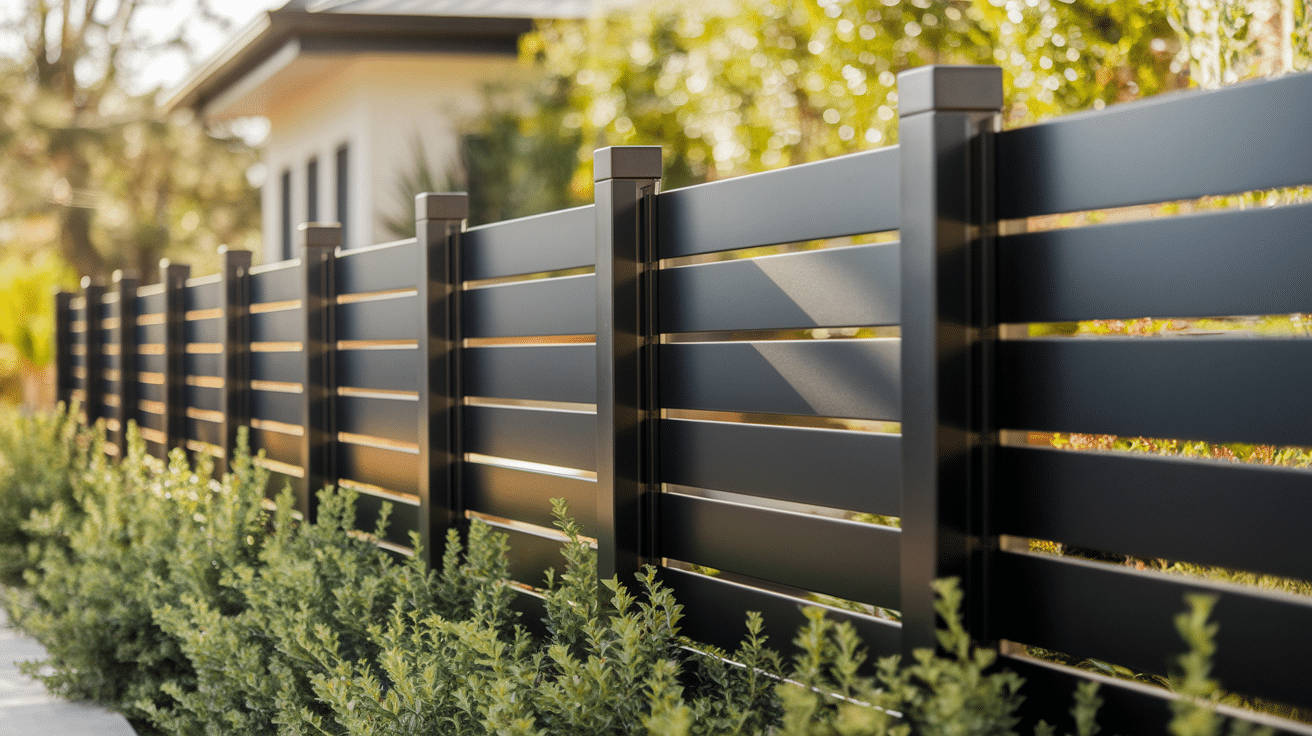
Aluminum privacy fences with slats combine the light weight of aluminum with closely spaced slats for privacy. These fences won’t rust and need almost no upkeep.
- Privacy level: Good to excellent (depends on slat spacing)
- Cost: $35-$65 per linear foot
- Lifespan: 30+ years
- Best for: Modern homes seeking a sleek look that will last for decades
The powder-coated finish on these fences stays looking new with just occasional washing. No painting needed, ever.
Most brands come with lifetime warranties against cracking, peeling, and fading.
14. Corrugated Metal Fence
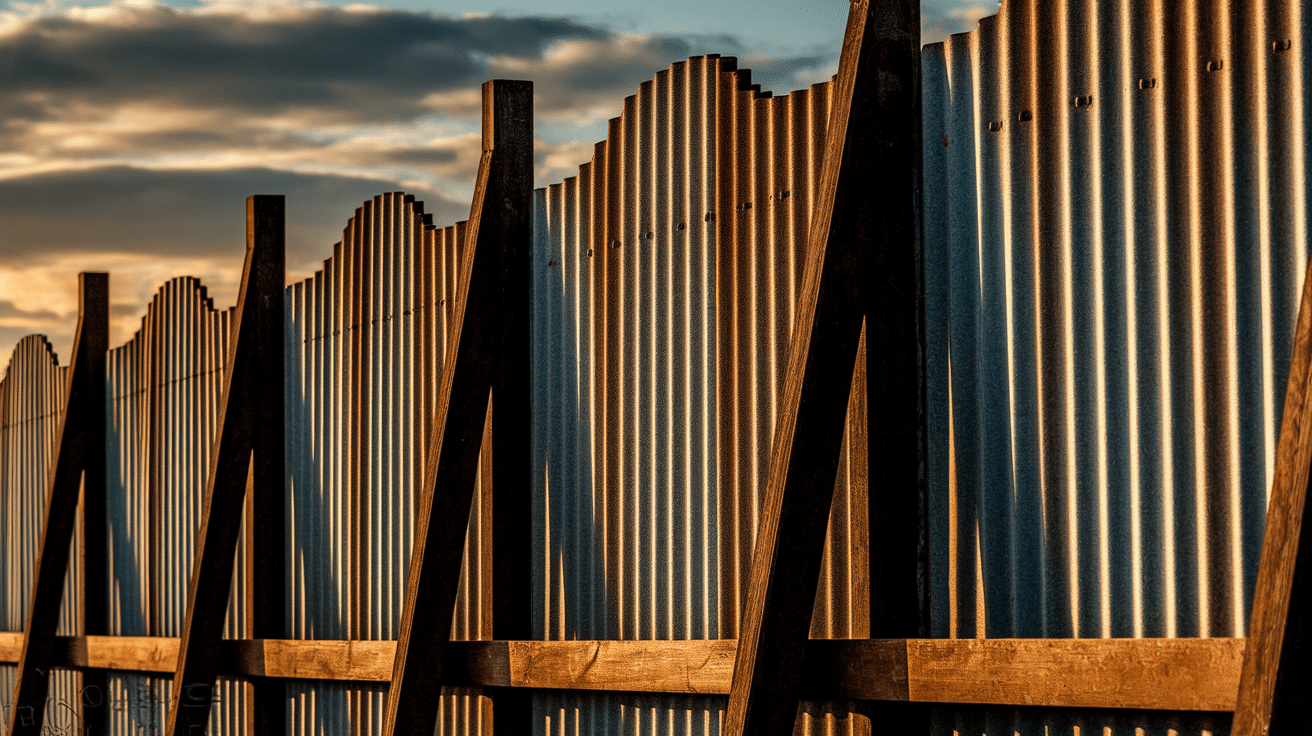
Corrugated metal fences use wavy metal panels (often steel) framed with wood or metal posts. This industrial-inspired look has become popular for urban and modern homes.
- Privacy level: Complete, solid panels with no gaps
- Cost: $25-$45 per linear foot
- Lifespan: 20-40 years
- Best for: Modern, industrial, or farmhouse-style homes
These fences weather naturally over time, with some developing a rustic patina. Galvanized panels resist rust but will eventually show age, which many people find adds character.
The wavy shape makes these fences stronger than flat panels.
15. Wrought Iron with Privacy Inserts
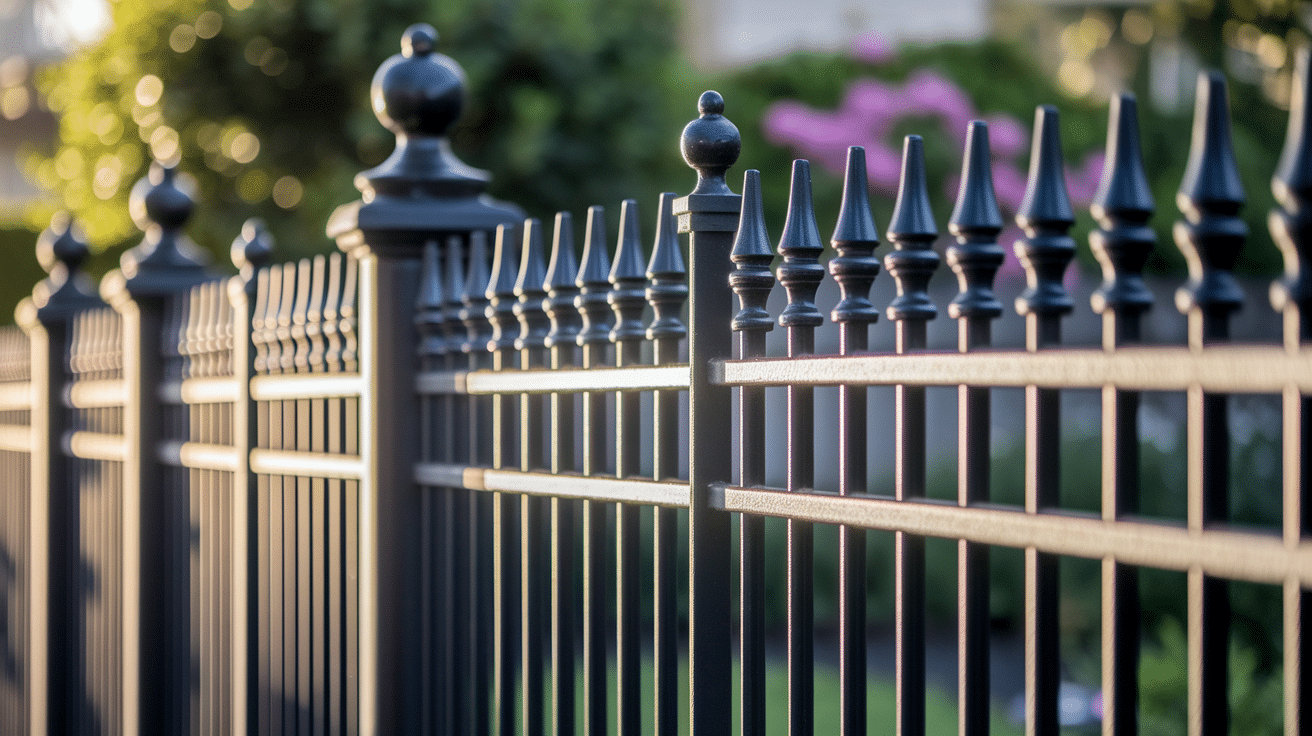
Wrought iron fences with privacy inserts blend classic ironwork with modern materials. The iron frame provides strength while the inserts block the view.
- Privacy level: Variable (depends on insert type)
- Cost: $45-$100+ per linear foot
- Lifespan: 50+ years with proper care
- Best for: Upscale homes wanting security with privacy
This fence type requires more care than others, necessitating yearly checks for rust spots and touch-ups as needed.
The inserts might be wood, metal, or fabric, each with its own care needs.
The benefit comes in having a fence that likely outlasts the homeowner.
16. Laser-Cut Metal Screen Fence
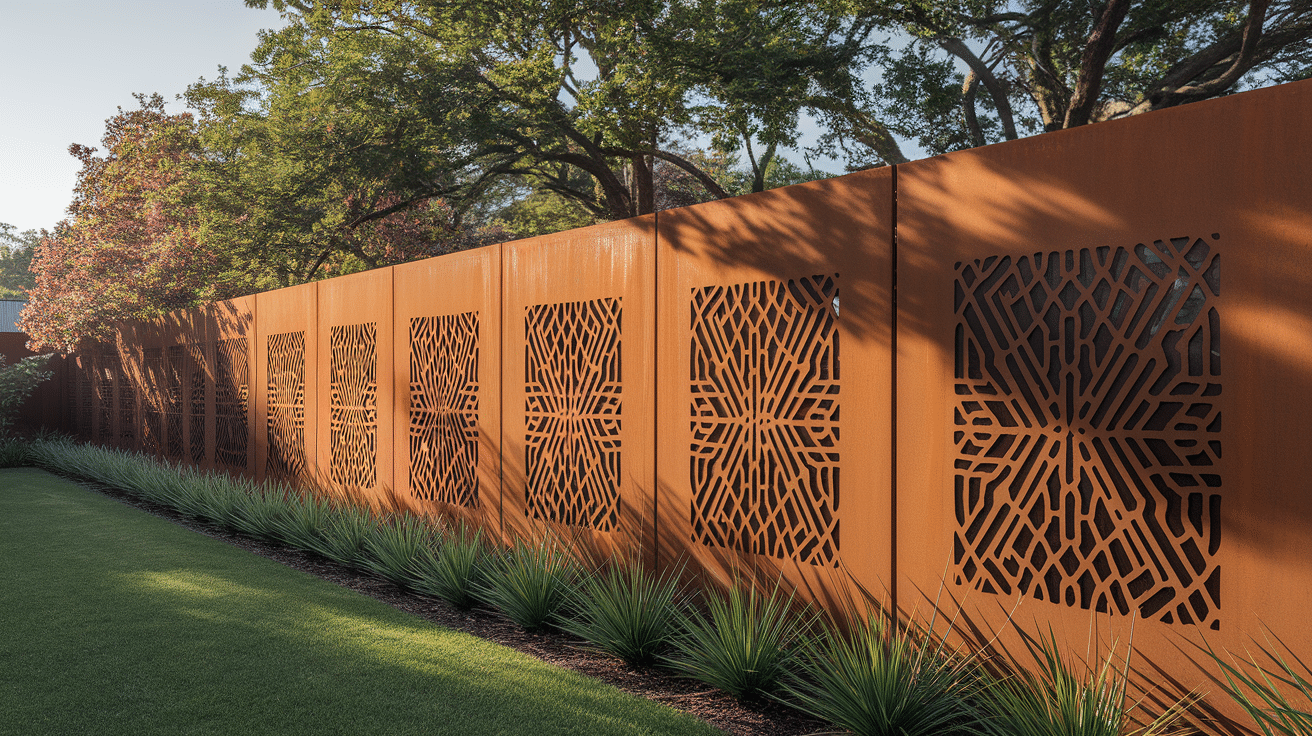
Laser-cut metal screen fences use precision-cut patterns in metal panels to create partial privacy with artistic flair. The patterns can range from simple geometrics to complex designs.
- Privacy level: Moderate, pattern determines visibility
- Cost: $60-$150+ per linear foot
- Lifespan: 25+ years
- Best for: Design-focused homeowners wanting a statement fence
These fences cost more due to the custom pattern work but create a one-of-a-kind look.
Most use powder-coated aluminum or Corten steel that forms a self-protecting rust layer.
They’re perfect for hiding specific areas while adding major style points.
17. Steel Panel Privacy Fence
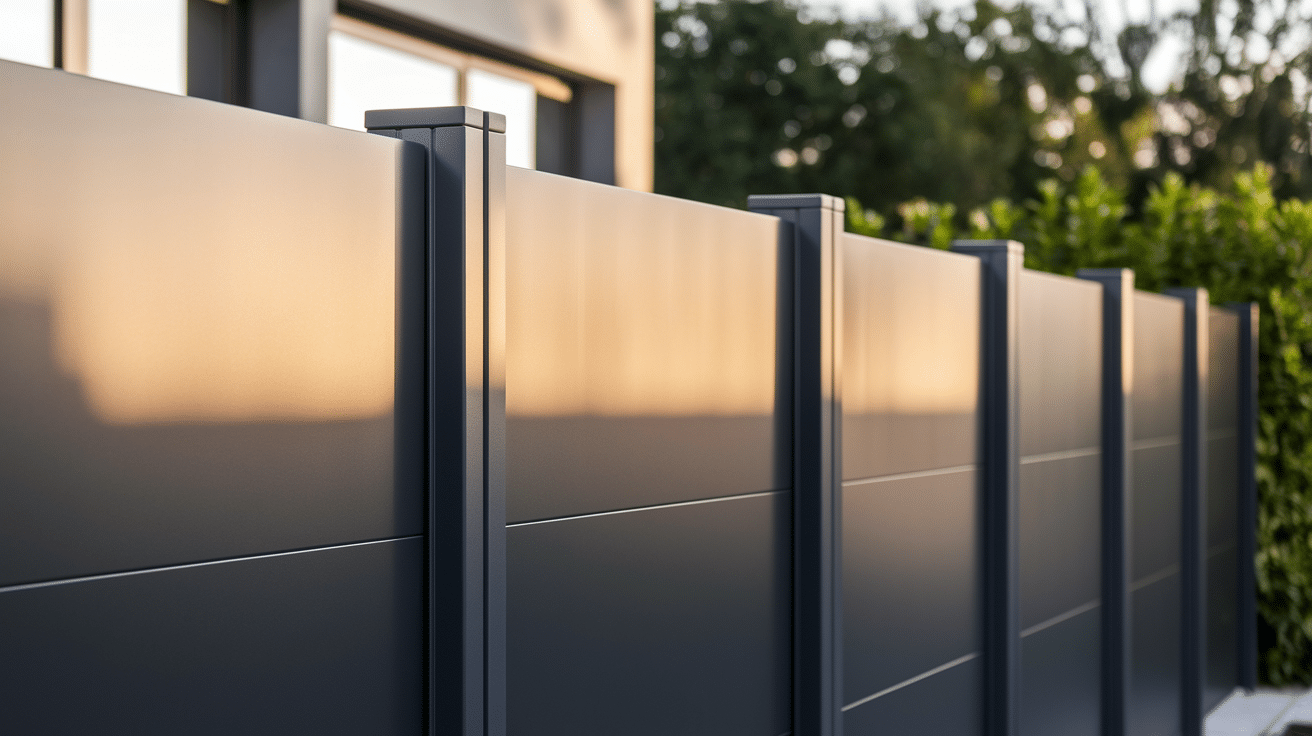
Steel panel privacy fences use solid steel sheets for maximum security and privacy. These industrial-strength barriers can be painted to match any color scheme.
- Privacy level: Complete, entirely blocks views
- Cost: $40-$80 per linear foot
- Lifespan: 25+ years with proper coating
- Best for: Areas needing maximum security along with privacy
These heavy-duty fences need proper paint or coating to prevent rust.
The smooth surface works well for displaying outdoor art or growing vines.
Their weight requires extra-strong post foundations, adding to installation costs.
18. Composite Wood Privacy Fence
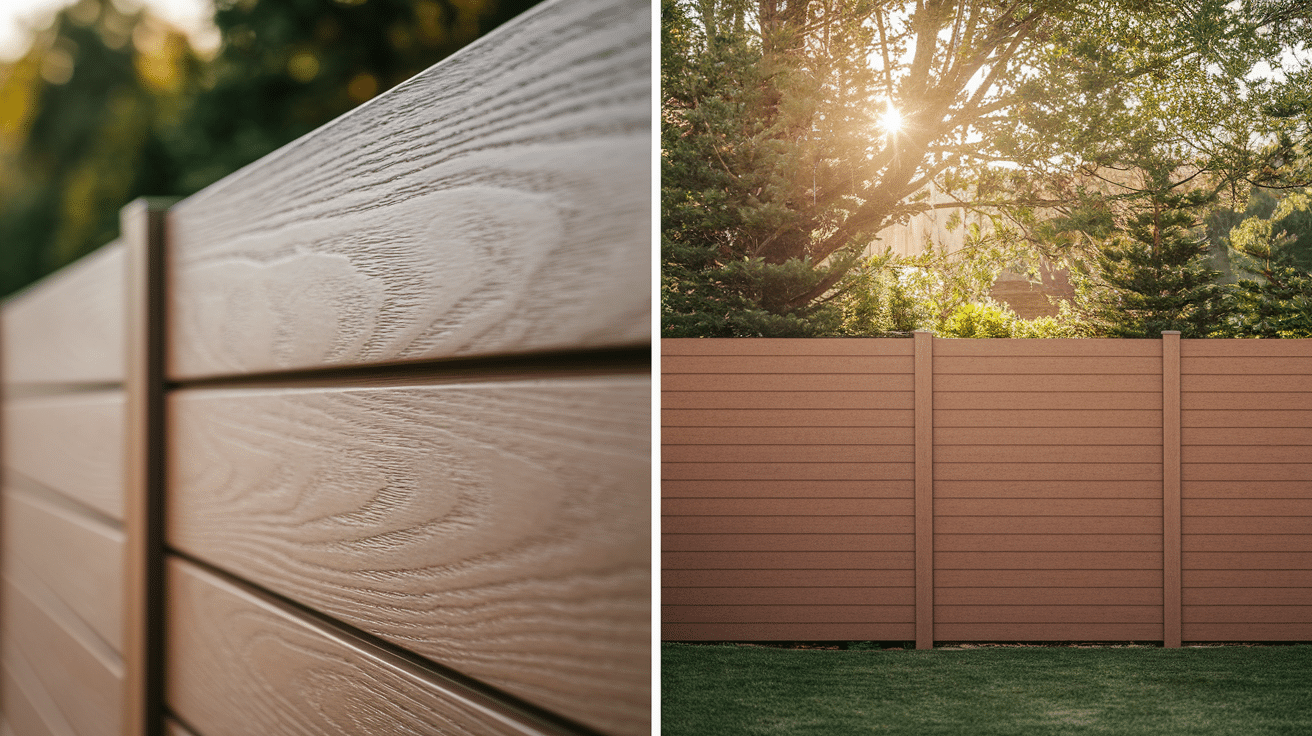
Composite wood fences blend wood fibers with plastic to create a material that looks like wood but lasts much longer. This mix gives you the best of both worlds.
- Privacy level: Complete, solid panels with no gaps
- Cost: $40-$70 per linear foot
- Lifespan: 20-30+ years
- Best for: Homeowners who want a wood look without the maintenance
These fences resist warping, splitting, and fading much better than real wood. Most people only need soap and water cleaning once a year.
The color goes all through the material, so scratches stay hidden, and no painting is ever needed.
19. Bamboo Fence (Rolled or Panel Style)
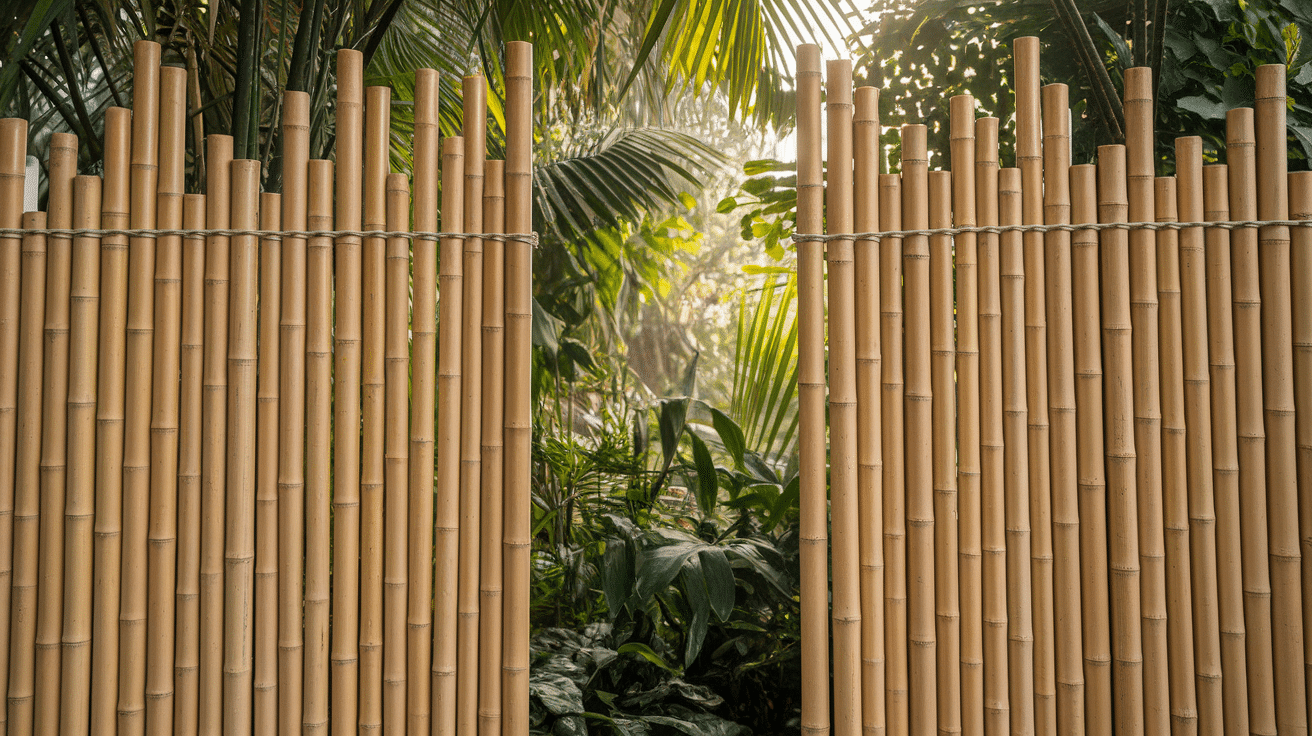
Bamboo fences bring a natural, tropical feel to any yard. Available in rolled mats or framed panels, bamboo creates a warm, organic privacy screen.
- Privacy level: Good to excellent (depends on bamboo thickness)
- Cost: $20-$50 per linear foot
- Lifespan: 8-15 years (depends on treatment and climate)
- Best for: Asian-inspired gardens or anyone seeking a natural, eco-friendly option
Bamboo weathers to a silver-gray over time unless sealed yearly with UV protectant. Higher-quality versions come pre-treated against insects and rot.
Rolled versions need sturdy framing to prevent sagging over time.
20. Recycled Plastic Privacy Fence
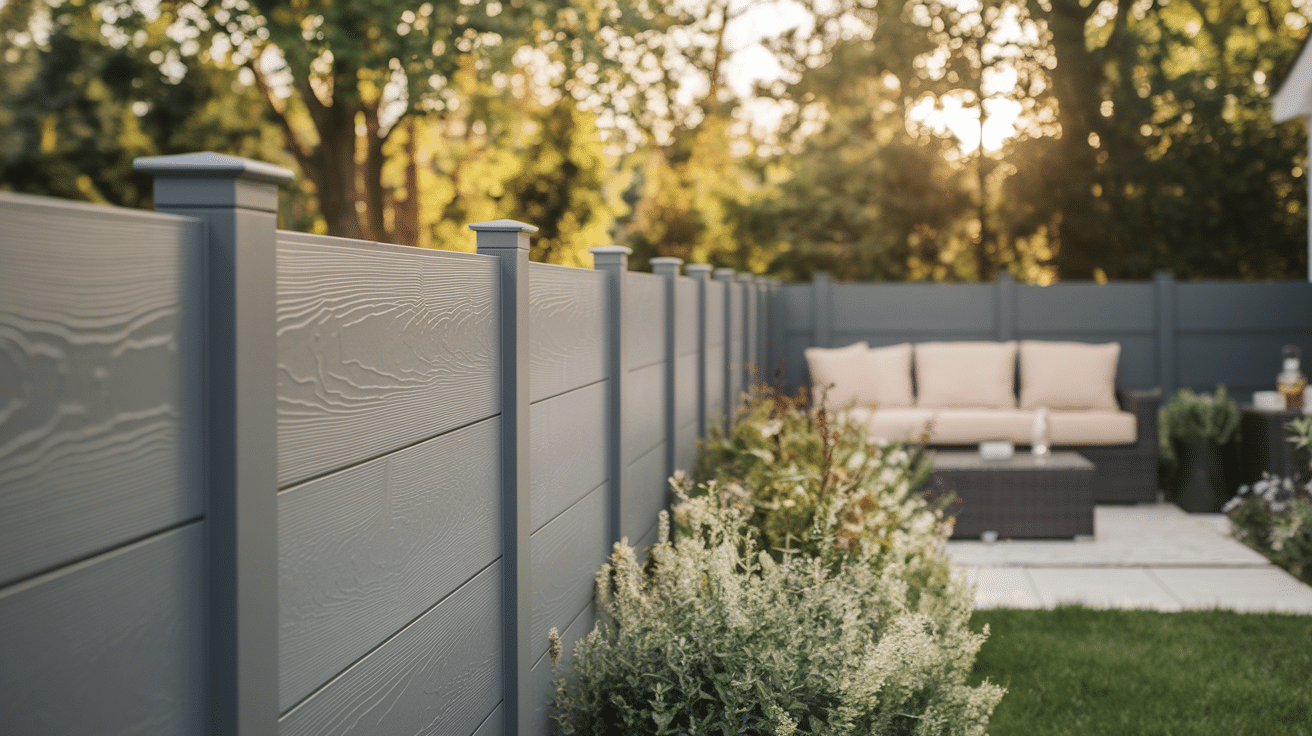
Recycled plastic fences turn old plastic into solid, maintenance-free barriers. These eco-friendly options help reduce landfill waste while providing long-lasting privacy.
- Privacy level: Complete, solid panels
- Cost: $30-$60 per linear foot
- Lifespan: 25+ years
- Best for: Environmentally conscious homeowners wanting a zero-maintenance fence
Made from materials like milk jugs and detergent bottles, these fences require no chemicals to maintain their appearance.
They won’t fade much, even in harsh sun, and never need painting.
Many brands offer lifetime warranties, showing their confidence in the product.
21. Gabion Wall with Fence Topper
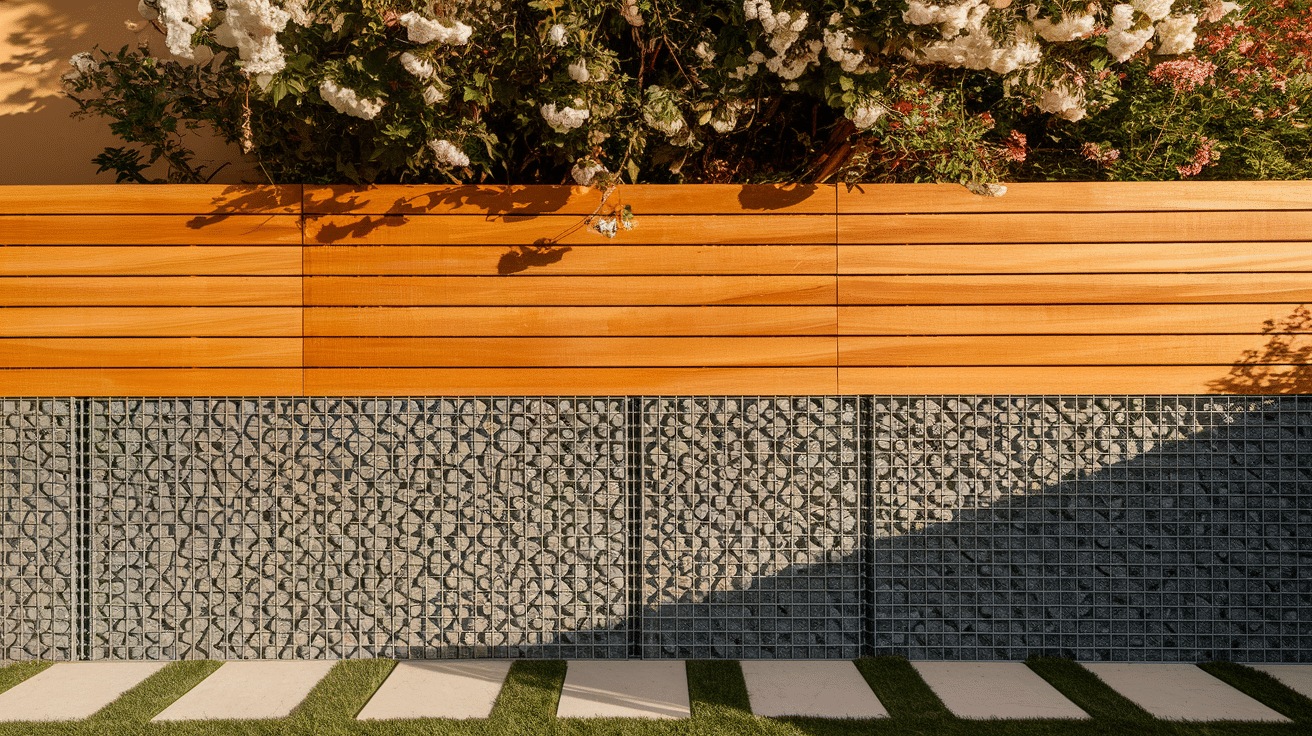
Gabion walls use metal cages filled with stones or concrete chunks to form solid bases, often topped with more traditional fencing.
This combo creates a striking boundary with excellent sound blocking.
- Privacy level: Excellent, especially for blocking sound
- Cost: $40-$120 per linear foot (depends on stone type and topper)
- Lifespan: 50+ years for the gabion portion
- Best for: Homes near busy roads or seeking an architectural statement
The stone-filled base needs zero maintenance and actually gets stronger over time as the stones settle. The wire cages may need checking for rust in coastal areas.
Adding plants between the stones softens the look while keeping privacy intact.
22. Concrete Privacy Wall with Openings
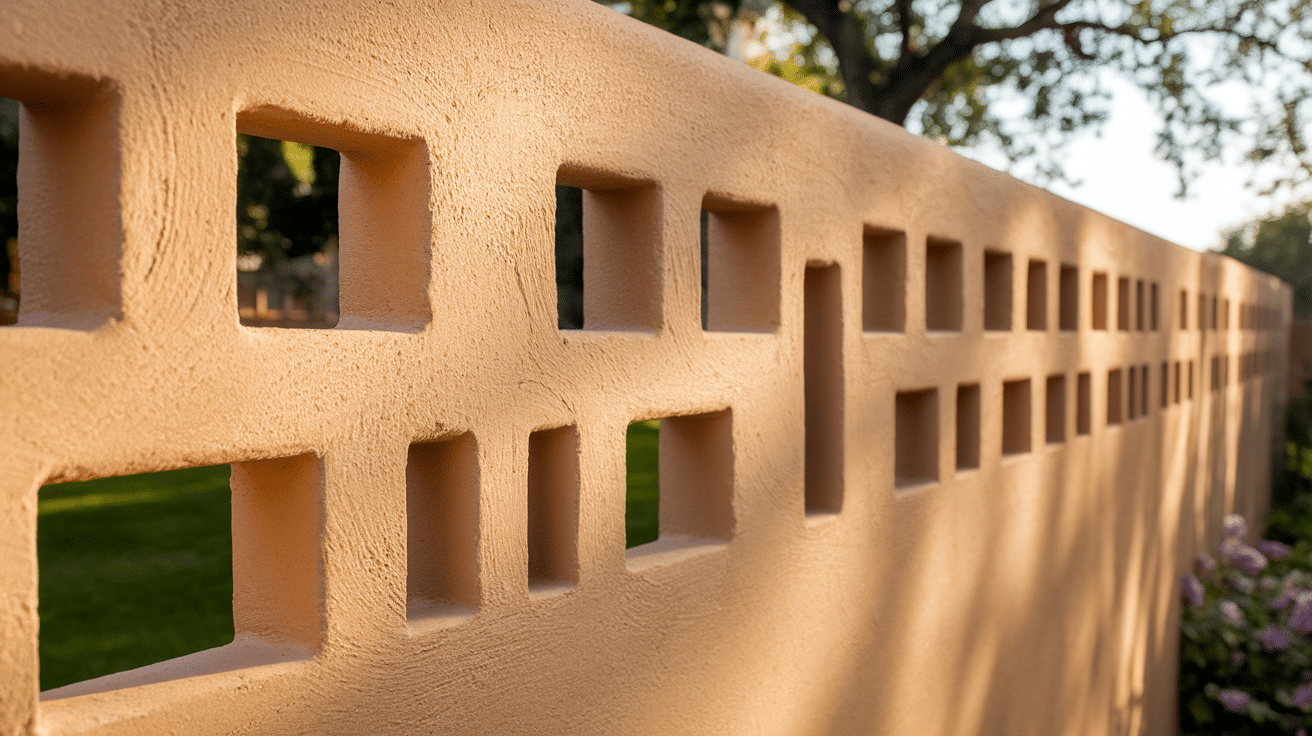
Concrete privacy walls with decorative openings offer fortress-like strength with artistic touches. The openings break up the heavy look while still maintaining privacy.
- Privacy level: Very good, strategic openings maintain overall privacy
- Cost: $70-$150+ per linear foot
- Lifespan: 50+ years
- Best for: Spanish, Mediterranean, or modern style homes seeking permanent privacy
These walls last for generations and require little care. The initial cost is high, but you’ll never need to replace them.
Decorative openings can hold colored glass or pottery for added interest.
23. Hedge (Boxwood, Privet, or Arborvitae)
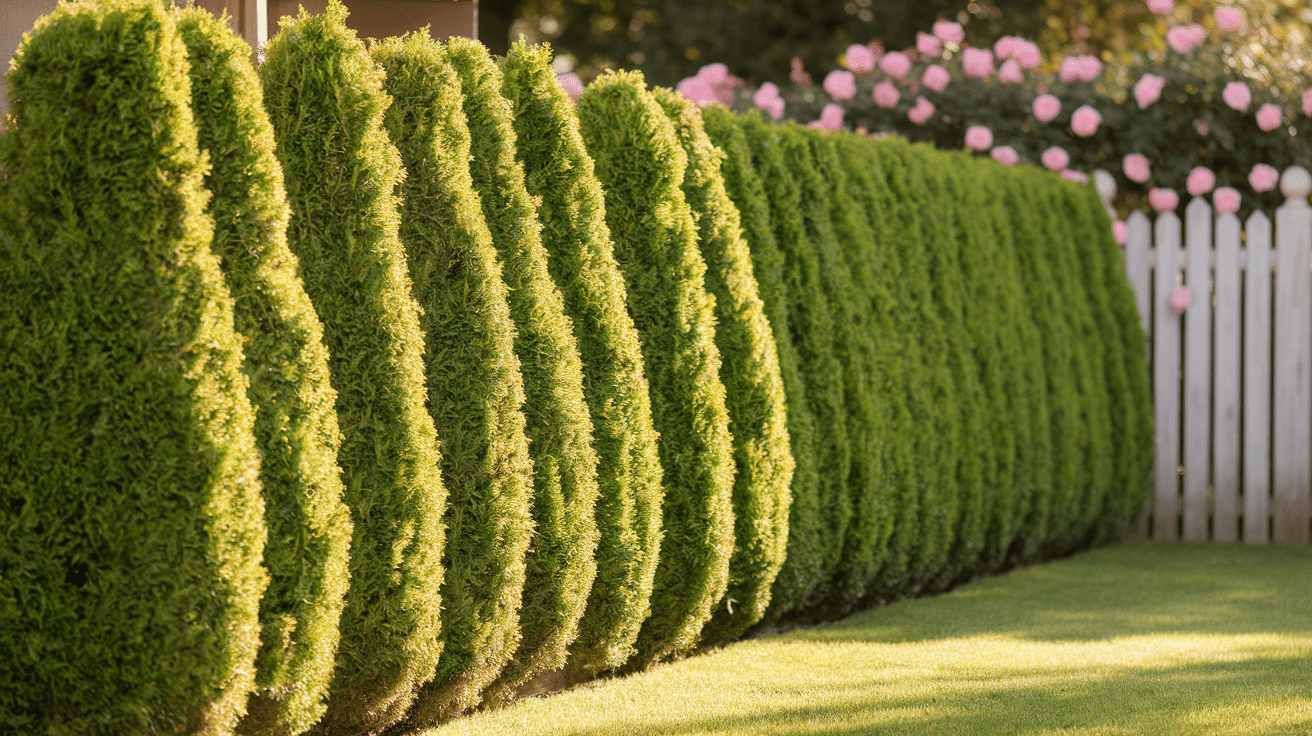
Hedges use closely planted shrubs to form dense green walls.
The most popular choices include boxwood for formal looks, privet for fast growth, and arborvitae for height and year-round screening.
- Privacy level: Excellent when mature, completely blocks views
- Cost: $15-$50 per linear foot planted (depends on plant size and type)
- Lifespan: 25-50+ years for most varieties
- Best for: Homeowners wanting a natural look that improves with age
Hedges need regular trimming (2-3 times yearly) to stay neat and full. They also need watering during dry spells for the first few years.
The payoff comes in a living fence that grows more valuable each year and provides habitat for birds and wildlife.
24. Espaliered Trees (Trained on Trellis)
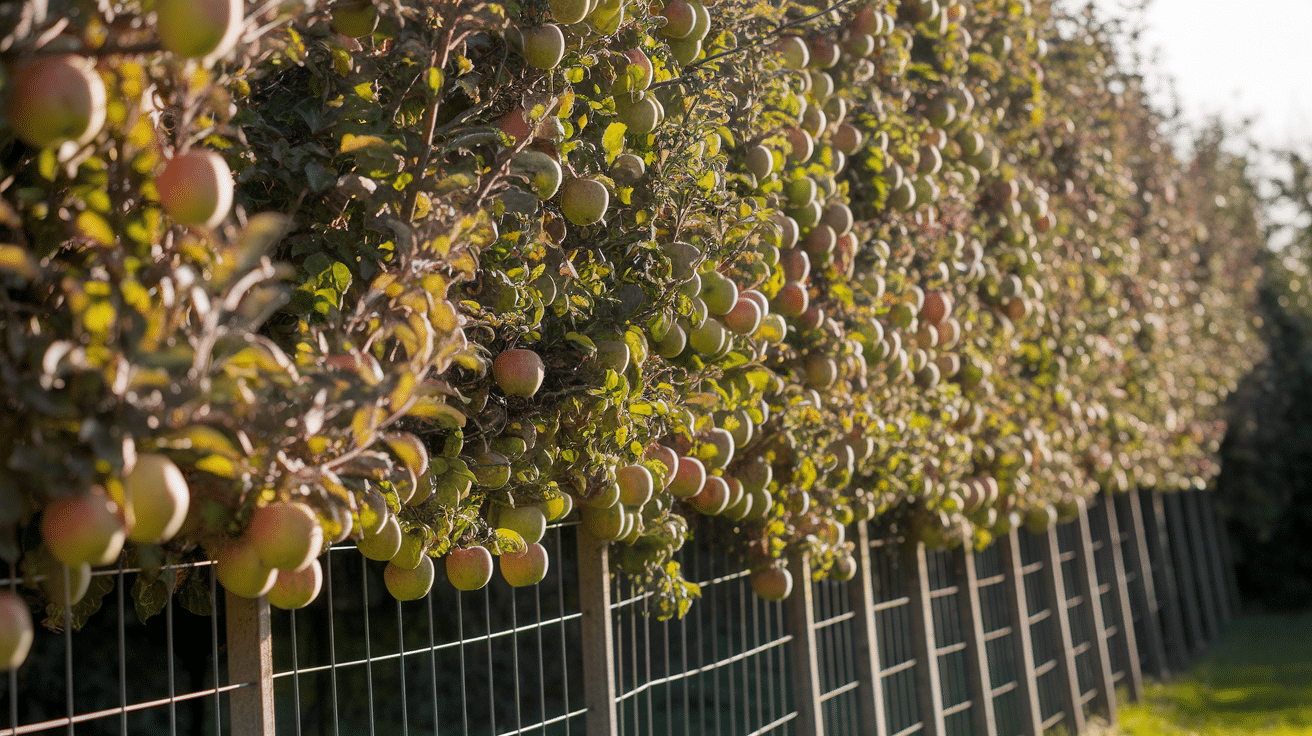
Espaliered trees grow flat against a trellis in artistic patterns.
This space-saving technique turns fruit or ornamental trees into living screens that produce food or flowers.
- Privacy level: Moderate, creates filtered screening
- Cost: $20-$60 per linear foot (depending on tree type and support structure)
- Lifespan: 20-50+ years, depending on tree species
- Best for: Small spaces where both beauty and function matter
These living fences need regular pruning to maintain their flat shape. The effort pays off in a fence that can produce apples, pears, or beautiful blooms.
Training takes several years, but the mature result creates a one-of-a-kind boundary.
25. Willow Fence (Living Willow Structure)
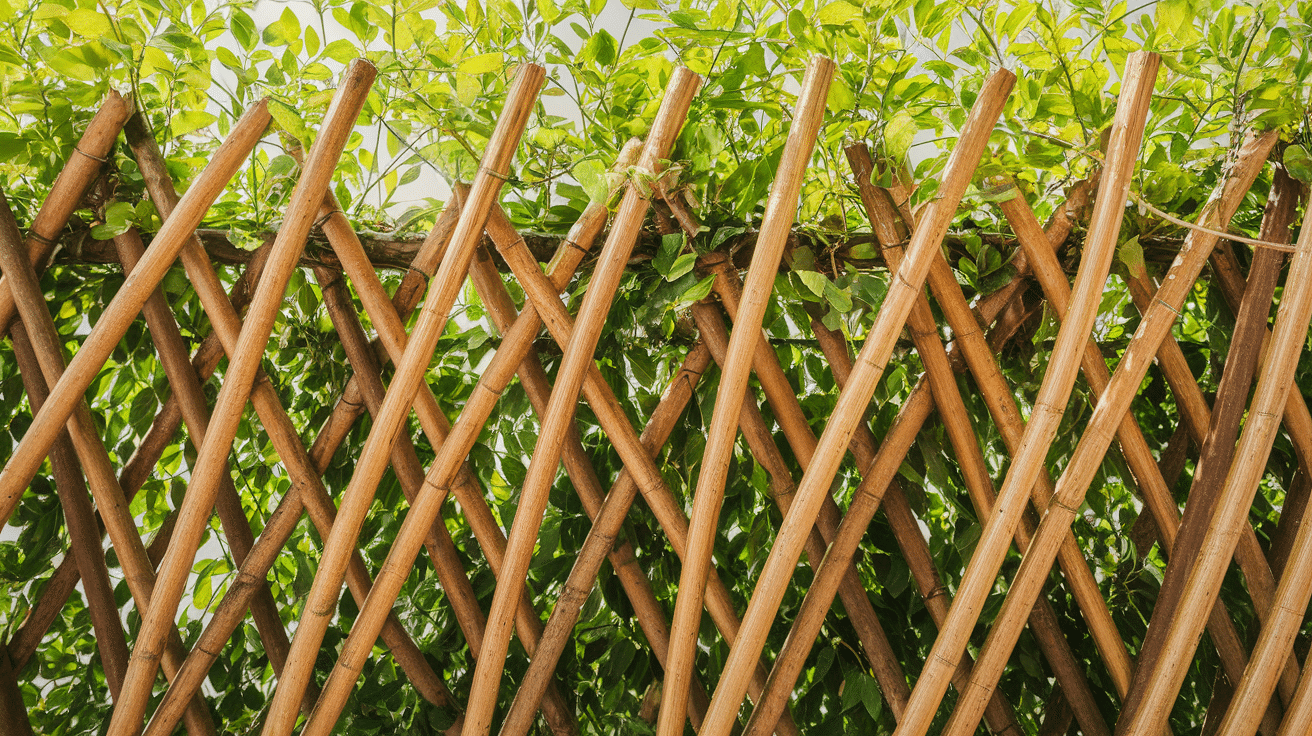
Living willow fences weave fresh willow saplings that root and grow into merged structures.
The result creates a truly living fence where the posts and rails continue growing together.
- Privacy level: Good in summer, moderate in winter when leaves drop
- Cost: $15-$40 per linear foot (mostly labor costs)
- Lifespan: 25+ years with proper care
- Best for: Moist areas where ordinary fences might rot
This fence type needs yearly pruning to control growth and maintain its shape. New shoots must be woven back into the structure.
The unique, artistic look changes with the seasons, becoming a garden talking point.
26. Ivy-Covered Trellis Fence
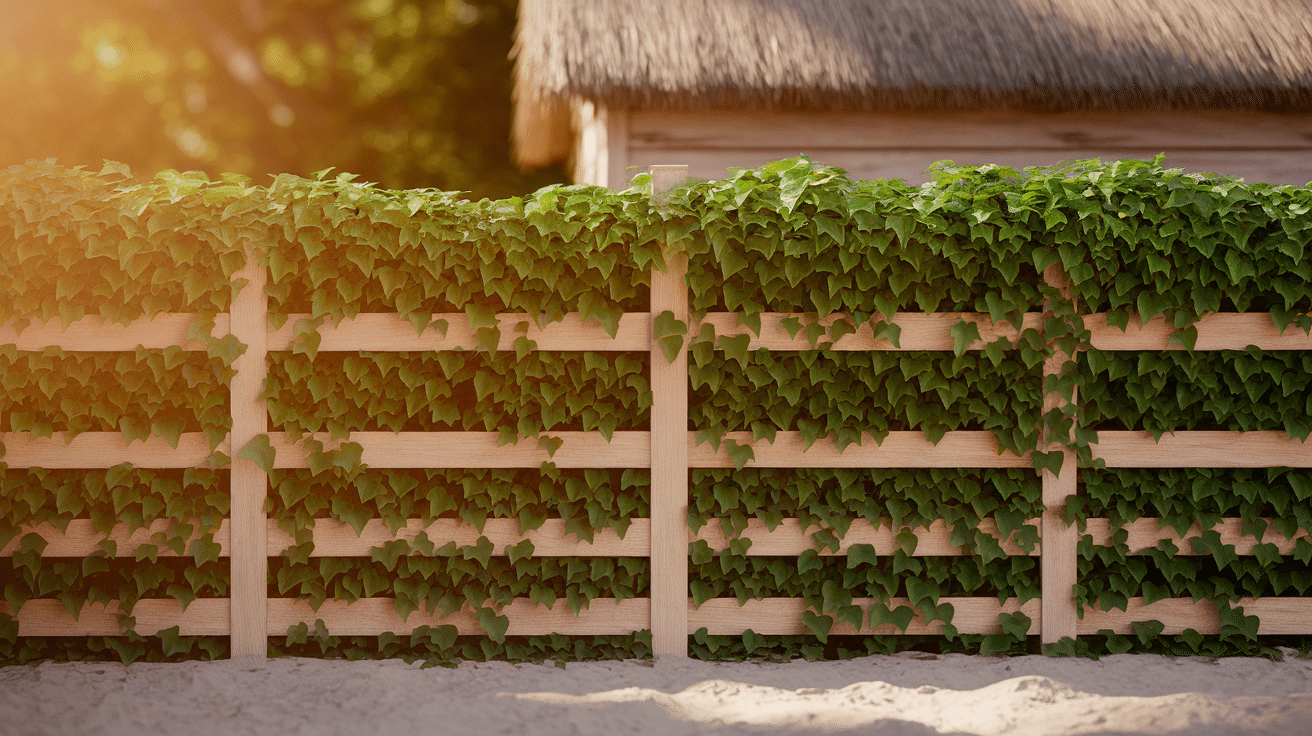
Ivy-covered trellis fences pair a simple frame with climbing vines for an affordable green screen.
The structure provides immediate support while plants grow to fill in the gaps.
- Privacy level: Poor initially, excellent when filled in (1-3 years)
- Cost: $10-$30 per linear foot plus plants
- Lifespan: 10-15 years for trellis, indefinite for plants with care
- Best for: Budget-conscious homeowners wanting natural screening
Fast-growing vines like ivy, clematis, or grape create privacy within a season or two.
The support structure can be as simple as posts with wire mesh or as fancy as a custom wooden lattice.
Plants need pruning once or twice yearly to keep them from becoming too heavy.
27. Bamboo Screening with Metal Frame
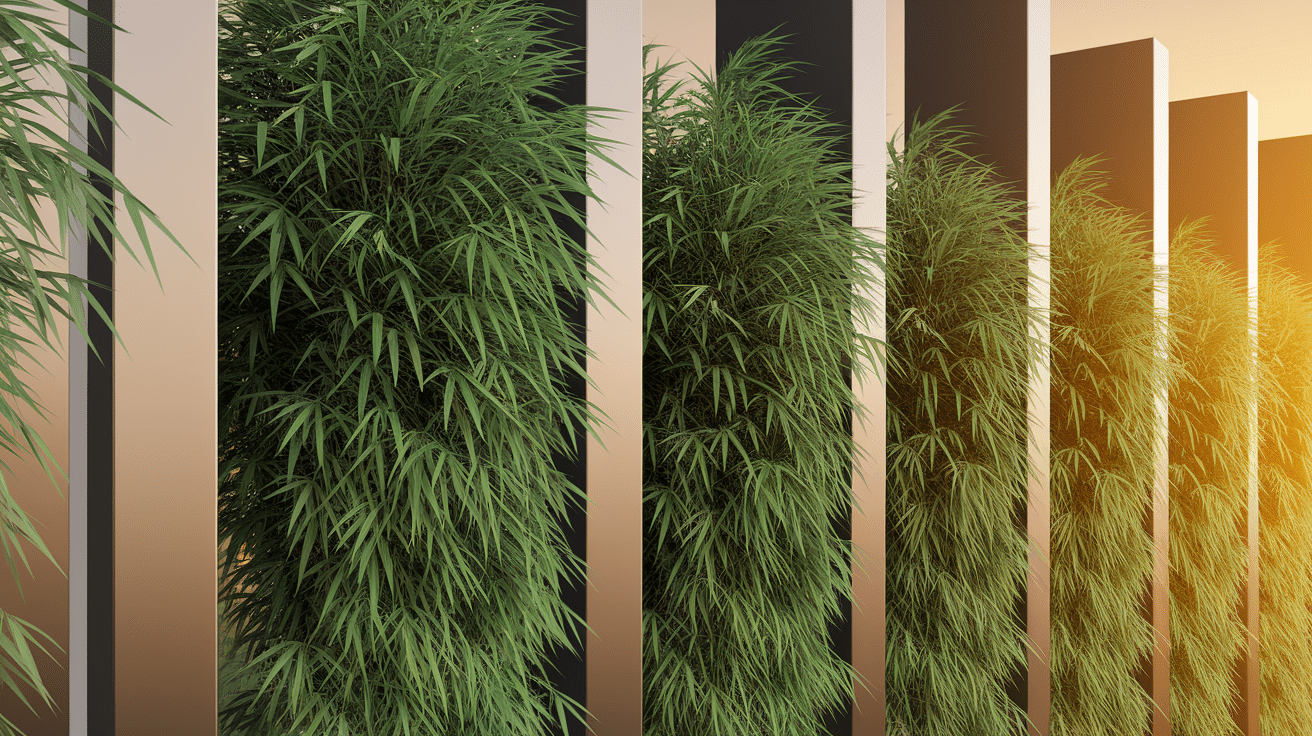
Bamboo screening with metal frames combines fast-growing bamboo plants with sturdy frames to contain and direct their growth.
This solution offers quick privacy with lasting structure.
- Privacy level: Excellent, dense foliage creates solid screening
- Cost: $30-$70 per linear foot installed
- Lifespan: 20+ years for the frame, bamboo continues renewing itself
- Best for: Modern yards seeking a clean, architectural plant screen
The metal frame keeps bamboo from spreading where it’s not wanted (a common problem with bamboo). Clumping varieties need less containment than running types.
This option combines the clean lines of metal with the natural movement and sound of bamboo leaves.
28. Frosted Glass Panel Fence
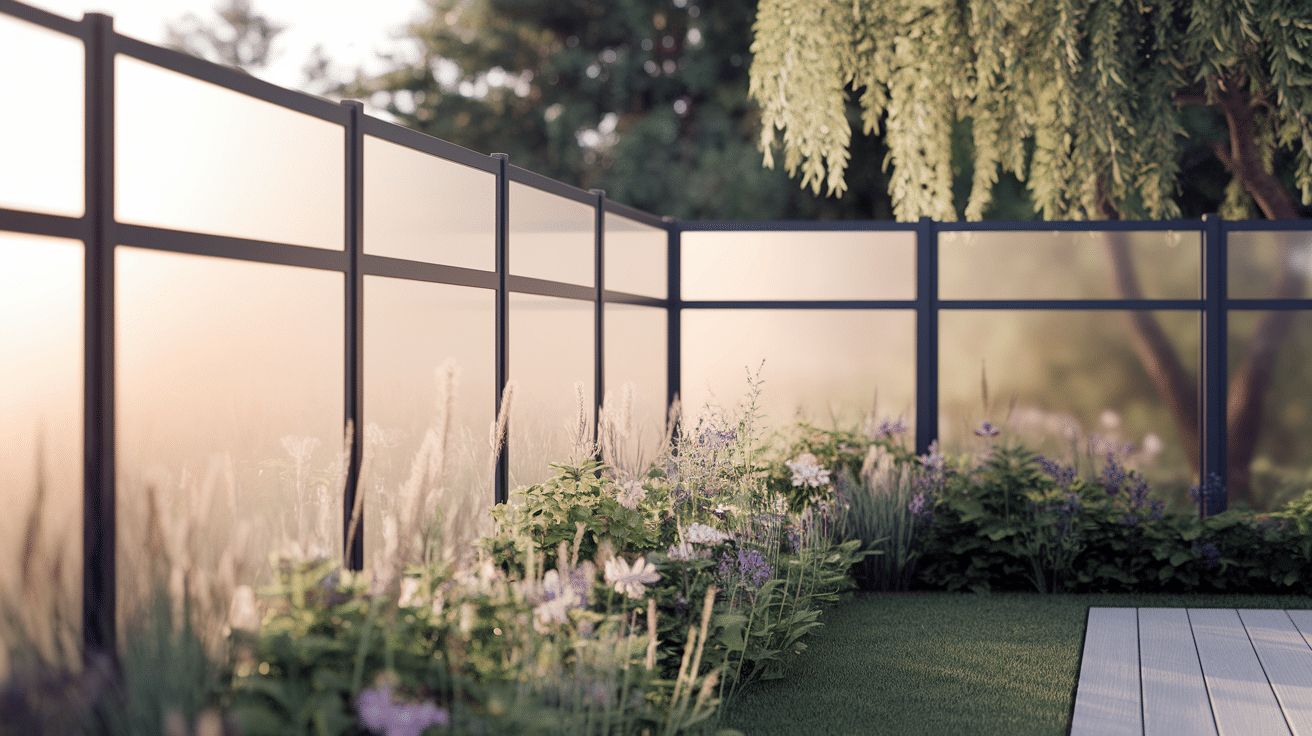
Frosted glass panel fences use tempered glass panels that let light through while blocking clear views. The result feels open yet private at the same time.
- Privacy level: Good, obscures details while allowing light
- Cost: $80-$200+ per linear foot
- Lifespan: 20+ years
- Best for: Modern and contemporary homes, especially in urban settings
These panels need just occasional cleaning with glass cleaner to stay looking good.
The tempered glass stands up to impacts and weather much better than regular glass.
Metal frames hold the panels and come in various finishes to match other exterior elements.
29. Vertical Garden (Green) Privacy Wall
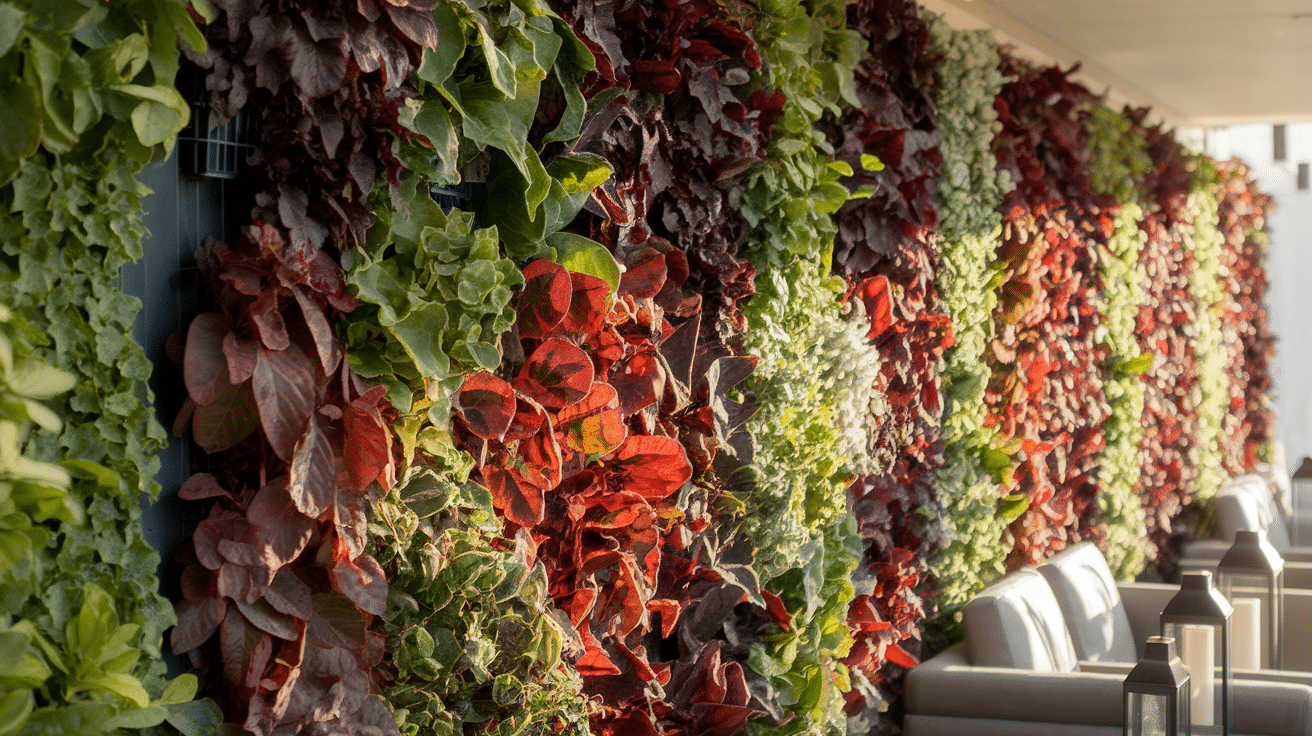
Vertical garden privacy walls use special panels filled with soil to grow plants vertically.
This living artwork creates privacy while improving air quality and adding green space.
- Privacy level: Excellent when fully planted, creates a wall of plants
- Cost: $ 100-$ 300+ per linear foot (depending on system complexity)
- Lifespan: 10-20+ years for structure; plants can be replaced as needed
- Best for: Urban spaces or areas where ground planting isn’t possible
These systems need regular watering (often automated) and plant maintenance.
The payoff comes in a beautiful, ever-changing privacy screen that draws compliments and provides a habitat for beneficial insects and birds.
Plants can be swapped out to change looks seasonally.
30. Sliding Wooden Screen Fence
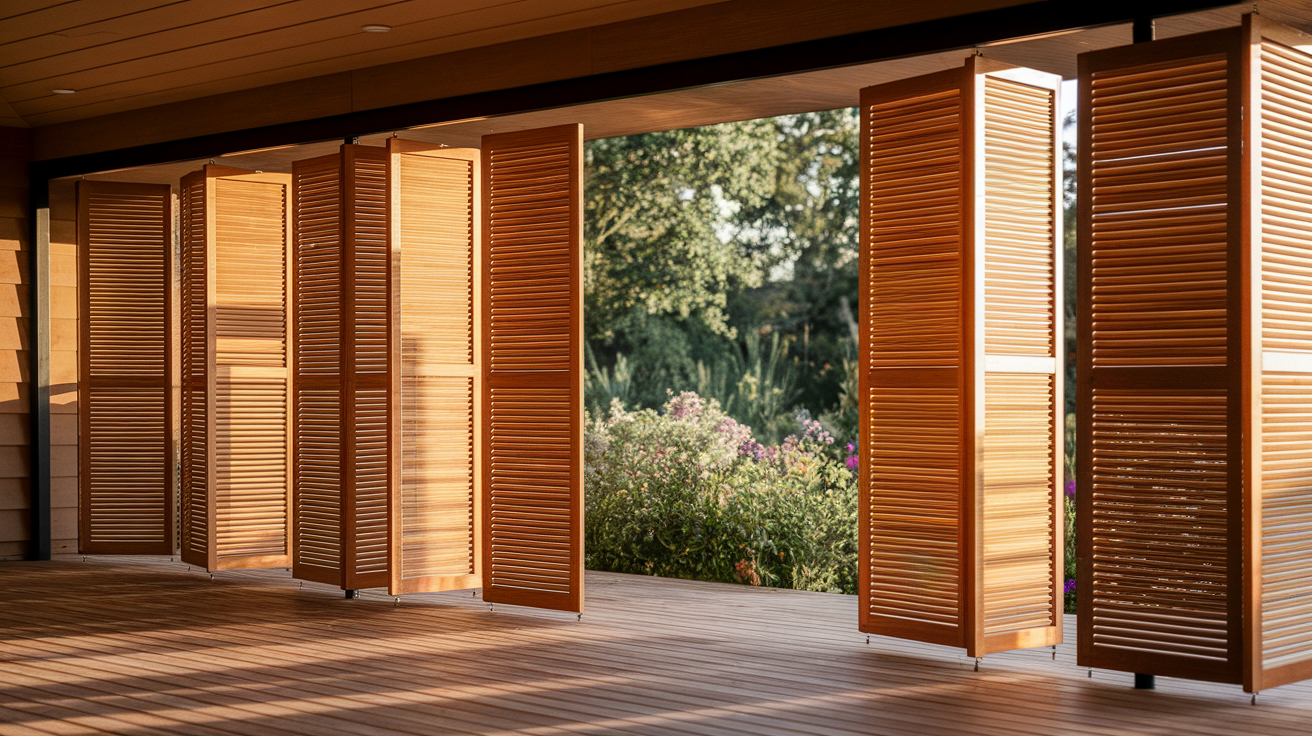
Sliding wooden screen fences use panels that move along tracks, allowing users to adjust privacy levels as needed.
The ability to open or close sections makes these fences extremely functional.
- Privacy level: Adjustable, from fully open to completely private
- Cost: $70-$150 per linear foot
- Lifespan: 15-20 years with proper care
- Best for: Areas where flexibility matters, such as around hot tubs or dining spaces
The tracks and hardware need occasional lubrication to keep the panels sliding smoothly.
Wood components require standard wood maintenance (staining or sealing every 2-3 years).
However, their versatility makes them worth the extra cost for many homeowners.
31. Geometric Pattern Metal Fence
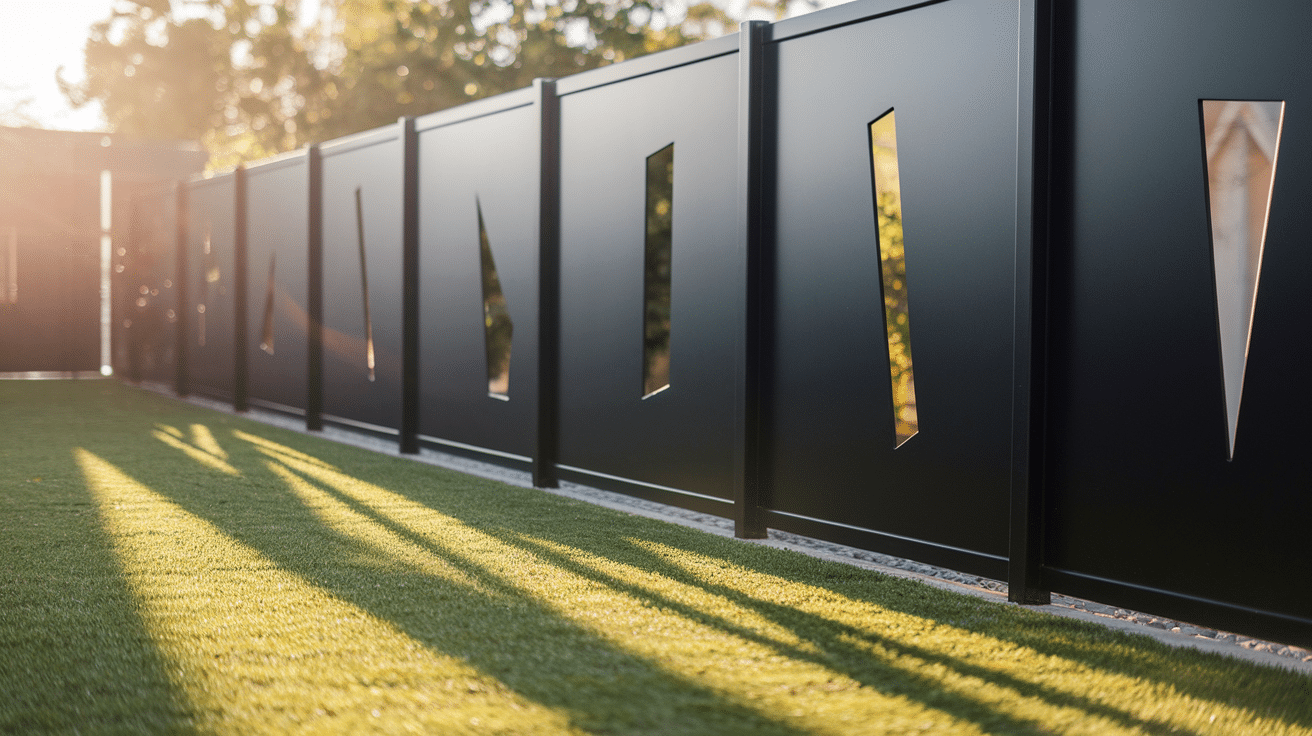
Geometric pattern metal fences use laser-cut or water-jet-cut metal sheets to create privacy with artistic patterns.
They make strong design statements while serving practical needs.
- Privacy level: Moderate to good (depends on pattern density)
- Cost: $60-$180 per linear foot
- Lifespan: 25+ years with proper coating
- Best for: Design-focused homes wanting a fence that doubles as art
Most use powder-coated steel or aluminum that needs very little upkeep. The patterns cast interesting shadows that change throughout the day, adding visual interest.
These fences become focal points rather than just boundaries.
Factors While Considering a Privacy Fence
Before you buy a fence, consider what matters most to your home. The right fence should match your needs and not just look good.
- Height Requirements: Most privacy fences are 6 to 8 feet tall. The taller the fence, the more privacy it provides, but check local rules first.
- Budget Constraints: Costs vary widely based on materials. Wood can be cheaper to install but needs more upkeep, while vinyl costs more upfront but lasts longer.
- Maintenance Needs: Some fences require regular care, such as staining or painting, while others can be cleaned with soap and water on an occasional basis.
- Local Weather Conditions: Heavy snow, strong winds, or lots of rain can damage certain materials. Choose a fence that can withstand your local weather.
- Neighborhood Rules: Many areas have strict fence regulations. Before starting, check with your homeowner’s association or local building department.
- Purpose of Fence: Is it just for privacy, or do you also need to keep pets in or wildlife out? Your main goal affects which type works best.
- Property Boundaries: Know exactly where your property lines are to avoid disputes with neighbors or having to move your fence later.
Remember that the perfect fence balances what you want, what you can spend, and what works for your specific yard.
Take time to consider these factors, and you’ll end up with a fence that makes you happy for years.
The Bottom Line
Picking the right privacy fence means thinking about what matters most to you. Is it for long-term value, low maintenance, or creating a certain look for your home?
The perfect fence balances your budget, style needs, and the amount of care you’re willing to give it.
Before making a final choice, check local rules about fence heights and materials.
Talk to neighbors if the fence will be on a shared property line. Get quotes from several fence companies to compare costs.
Remember that a good privacy fence does more than just block views; it adds security, reduces noise, and makes your outdoor space feel like an extension of your home.
With these options, you’ll find a privacy solution that perfectly suits your unique situation.
Have you built a privacy fence before? Tell us about your experience!

